Contribution of AGN to the Morphological Parameters of Their Host Galaxies up to Intermediate Redshifts of z ∼ 2
Abstract
1. Introduction
2. Data and Sample Selection
3. Methodology
3.1. Morphological Parameters at Intermediate Redshifts
3.2. Morphological Parameters at Intermediate Redshift with Added AGN
4. Analysis and Results
4.1. Impact of Magnitude, Redshift, and AGN on Morphological Parameters

- •
- CABR. In Figure 4 (top panels), it can be seen that this parameter is the most affected compared to other morphological parameters. On average, when considering the total sample of galaxies, early-types, and early-spirals, the variance in the parameter is significant in all magnitude and redshift conditions when the contribution of the AGN is equal to or larger than 25%, 50%, and 75%, respectively. For late-spirals, the CABR parameter undergoes significant changes above 20% in all magnitudes, redshifts, and AGN conditions. Figure A1 shows that the distribution of CABR after the simulations can move in both directions, towards higher and lower values compared to the non-simulated sample. Taking into account the definition of CABR, as described in Section 3, it can be interpreted that, when the parameter is shifted towards higher values the contribution of the AGN, increasing the flux within the inner radius, has the dominant effect compared to the impact of the magnitude and redshift, which is dimming the light in the galaxy, in particular in the outer regions. Similarly, when it is shifted towards lower values, it means that the magnitude and redshift have more impact on the CABR than the added AGN itself. We can observe that for 50% and 75% of the AGN added, the AGN contribution plays a dominant role independently of the magnitude and redshift. This means that if more light is added to the central part of the galaxy, according to the CABR definition, its values will increase. For 5–25% added AGN, AGN plays the dominant role up to mag_hz < 22, as the central light of the galaxy within 30% of the galaxy radius is less affected than the rest of the galaxy. At fainter magnitude limits (23 and above), the impact of the magnitude and redshift on the CABR becomes a dominant effect, affecting light in the entire galaxy.
- •
- GINI. This is the least affected parameter, with the lowest values of variance, as can be seen in Figure 4 (middle top panels). Even so, the total sample of galaxies and early-spirals will be significantly affected when the AGN contribution is equal to or larger than 25%, regardless of the magnitude and redshift limits. Again, late-spirals will be significantly affected in all cases, similarly to the CABR. On the other hand, the GINI parameter for early-types in all cases will suffer variations below 20%. The tendency of GINI to shift towards higher or lower values compared to the original sample is similar to that of CABR, but with smaller shifts. This is due to the difference in the definition of GINI and CABR, in which, although both are concentration parameters, CABR is much more sensitive to the concentration of light in the central part of the galaxy than GINI.
- •
- CCON. This parameter will undergo significant changes of more than 20%, in all cases of the total sample, due to the impact magnitude, redshift, and AGN on spiral galaxies, both early and late, as shown in Figure 4 (middle bottom panels). The early-types will be significantly affected only when the added contribution from the AGN is greater than 25%. In general, the change in the CCON parameter for the simulated sample will be towards higher values. However, for 50% and 75% of added AGN in the early-types and early-spirals (75% of AGN added for late-spirals), because the definition of CCON is the radius ratio and not the flux ratio, as in the case of CABR, the distribution of the simulated sample will start to change the trend towards lower concentrations in the simulated sample, compared to the lower AGN contributions. This effect is more pronounced in early-type galaxies, which, in general, have higher central concentrations and CCON values and are therefore more affected.
- •
- M20. This parameter will also undergo significant changes of more than 20%, in all cases of the total sample, early- and late-spirals, as shown in Figure 4 (bottom panels). In early-type galaxies, the variations in M20 are around 20% up to the added contribution of AGN of 25%. For AGN contributions above this value, M20 is more affected, with variations exceeding 30%.
- •
- ASYM. We found similar distributions of ASYM between simulated and original samples in most cases of magnitude, redshift, and AGN (see Figure A5). However, this parameter is very sensitive to noise, as has already been studied and discussed in [37]. Similar results were reported in other studies (e.g., [33,72,73]). Therefore, we do not suggest its use except in combination with other morphological parameters.
- •
- SMOOTH. We find larger changes in the distribution of this parameter in early-type galaxies than in spiral galaxies, but towards lower values, as can be seen in Figure A6. This parameter is not convenient to use due to the very small number of sources for which it can be measured, as mentioned above.
4.2. Impact of Magnitude and Redshift on the Morphological Parameters of Active Galaxies
- •
- CABR. Up to 50% of the AGN added, the effect of magnitude and redshift is up to ∼20% for all morphological types (with slightly higher values of up to 30% for late-spirals), as can be seen in Figure 5 (top panels). The change in variance, towards lower values of CABR, increases with magnitude, as expected (except for the AGN contribution of 75%). The highest measured CABR values are obtained at mag_hz < 21, when the outskirts of a galaxy are the ones mainly affected, leading to higher CABR values. On the other hand, at mag_hz < 25 the brightness of the entire galaxy is affected, giving generally lower CABR values than at z ∼ 0. The most significant impact of magnitude and redshift on active galaxies is observed for 75% of the AGN added contribution, being around 20% for early-type galaxies, 20–35% for early-spirals, and 30–40% for late-spirals.
- •
- GINI. Again, this is the most stable of all parameters, as can be seen in Figure 5 (middle top panels). In this case, for active galaxies with an AGN contribution of 25–75%, the impact of the magnitude and redshift on GINI is ≲20% for all morphological types (except when the AGN contribution is 25% for late-spirals and mag_hz < 23, then the variance is up to 30%). In early-type galaxies, the difference is insignificant for less luminous active galaxies, with AGN contributions of 5% and 10%. In the case of spirals, at magnitudes of ≤21 and ≤22 that mainly affect the disc, active galaxies at higher redshift will show higher GINI values with a variance of ∼15–30% for early-spirals and ∼30–40% for late-spirals. As the magnitude limit increases, which affects the brightness of the entire galaxy, the variance will decrease in both early and late spiral galaxies.
- •
- CCON. The impact of the magnitude and redshift on the CCON concentration index in early-type active galaxies will be insignificant (<20%), up to an AGN contribution of 25%. These differences become significant (20–35%) for a 50% and 75% AGN contribution (see Figure 5, middle bottom panels). For the spiral active galaxies, the variance is significant in all cases, varying between 20 and 30% and 20 and 40% in the cases of early- and late-spiral galaxies, respectively. In all cases, as the magnitude limit increases, affecting a larger and larger fraction of the galaxy light, the CCON parameter of galaxies in COSMOS-like conditions will move towards lower values.
- •
- M20. The behavior of this parameter at and in COSMOS-like conditions is shown in Figure 5 (bottom panels) for all morphological types. In all cases, the impact of the magnitude and redshift is insignificant (<20%) for all morphological types when the AGN contribution is up to 25%. The variances become significant (20–36%) at 50% and 75% AGN contribution.
- •
- ASYM and SMOOTH. The results and conclusions of these two parameters, shown in Figure A11 and Figure A12, respectively, are similar to those discussed in the previous section.
4.3. Impact of AGN on the Morphological Parameters of Intermediate-Redshift Galaxies in COSMOS-like Conditions

- •
- CABR. In general, there are no significant differences up to the added AGN contribution of 25%, in the case of the early-type and early-spiral galaxies, as shown in Figure 6 (top panels). For the larger contributions from the AGN, of 50% and 75%, the variance becomes significant (above 20%). In the case of late-spirals, the CABR parameter will be significantly affected in almost all cases except for the lowest AGN contributions of 5–10% and magnitude limits of mag_hz < 22. In this analysis, the AGN contribution dominates, and therefore, in almost all cases, the values of CABR after adding the AGN at the center of a galaxy tend to shift towards higher values, due to the definition of the CABR parameter.
- •
- GINI. This is again the most stable parameter showing in almost all cases the variance of <20%, regardless of morphological type, as seen in Figure 6 (top bottom panels). This means that, similar to what we found in [38] that AGN does not have a significant impact on GINI at z ∼ 0, is also true for galaxies at higher redshift, when comparing non-active and active galaxies in COSMOS-like conditions.
- •
- CCON. For early-type galaxies, the change in variance is ≤20% in almost all cases except in 75% added AGN contribution, as shown in Figure 6 (middle bottom panels). In spiral galaxies, this parameter will undergo significant changes above 40%, where the added AGN contribution is >25%, and 20–25% changes for 10% added AGN. Only in the case of 5% added AGN, the variance in CCON is insignificant. Once again, we are observing the complex changes in behavior of the CCON parameter, as in Section 4.1 and Section 4.3, and its change from higher values to lower values depending on the AGN contribution, compared to the reference sample in COSMOS-like conditions without AGN added. For all morphologies, up to the AGN contribution of 25%, the simulated sample with AGN shows higher values than the reference sample without AGN added. When the AGN contribution is 50% and 75%, CCON will move to lower values at all magnitudes, as most of the flux is now accumulated within the very small radii.
- •
- M20. In early-type galaxies, this parameter will now go through significant changes only when the added AGN contribution is >50%, as shown in Figure 6 (bottom panels). In spiral galaxies, the variance is significant for AGN added contribution of ≥25% at all magnitudes, and at the highest magnitude limits of mag_24 < 24 and mag_24 < 25 when AGN contribution is 5% and 10%.
4.4. Morphological Diagrams
5. Discussion
6. Conclusions
- The greatest impact on morphological parameters is when considering the combined effect of magnitude, redshift and AGN. Combined, these effects affect morphological parameters of spiral galaxies more than early-type galaxies.
- The impact of the magnitude/redshift will affect the morphological parameters of active galaxies less than those of normal galaxies in COSMOS-like conditions. In general, in most cases, for an AGN contribution to the total flux of up to 50%, the impact of magnitude/redshift on the morphological parameters of active galaxies is <20%, being higher at fainter magnitudes.
- If the AGN contribution to the total galaxy flux is ≥50%, the AGN effect dominates the impact on all morphological parameters compared to the effect of magnitude/redshift in the case of all morphological types. For AGN contributions of <50%, the AGN will have a dominant effect up to 23, while at fainter magnitudes the impact of the magnitude/redshift will play a more important role in the change of morphological parameters than an AGN. The impact of AGN in combination with magnitude/redshift on morphological parameters under COSMOS-like conditions is particularly complex for spiral galaxies, compared to early-type galaxies, which are, in general, less affected.
- In general, in COSMOS-like conditions up to intermediate redshift of z ∼ 2 all four concentration parameters will undergo significant changes of >20% for >25% of the added AGN, similar to what we found previously at z ∼ 0, affecting spiral galaxies more than early-types and, in particular, late-spirals.
- We find that GINI is the most stable in terms of the effect of both AGN and magnitude/redshift, followed by the M20 moment of light, CCON, and finally CABR. ASYM and SMOOTH are very sensitive to the noise and image properties, and are measured for a much smaller fraction of the total sample.
- Finally, we find CABR vs. CCON and CABR vs. ASYM to be the most efficient diagrams in the classification of AGN host galaxies at higher redshift in COSMOS-like conditions, in particular up to mag_hz < 22 and AGN contribution of ≤25%, followed by the CABR vs. GINI diagram. We do not recommend using the GINI vs. M20 diagram to classify active galaxies in COSMOS-like conditions.
Author Contributions
Funding
Data Availability Statement
Acknowledgments
Conflicts of Interest
Abbreviations
| ACS | Advanced Camera for Surveys |
| AGN | Active Galactic Nuclei |
| ASYM | asymmetry index |
| BPT | Baldwin–Phillips–Terlevich diagram |
| CABR | Abraham concentration index |
| CCON | Conselice–Bershady concentration index |
| galSVM | galaxy Support Vector Machine |
| GINI | GINI coefficient |
| IRAF | Image Reduction and Analysis Facility |
| LINER | Low-Ionization Nuclear Emission-line Region |
| mag | magnitude |
| M20 | M20 moment of light |
| SDSS | Sloan Digital Sky Survey |
| SVM | support vector machine |
| TOPCAT | Tool for OPerations on Catalogues Furthermore, Tables |
Appendix A. Comparing the Local Sample (No AGN) with COSMOS-like Samples (Without and with AGN Added)
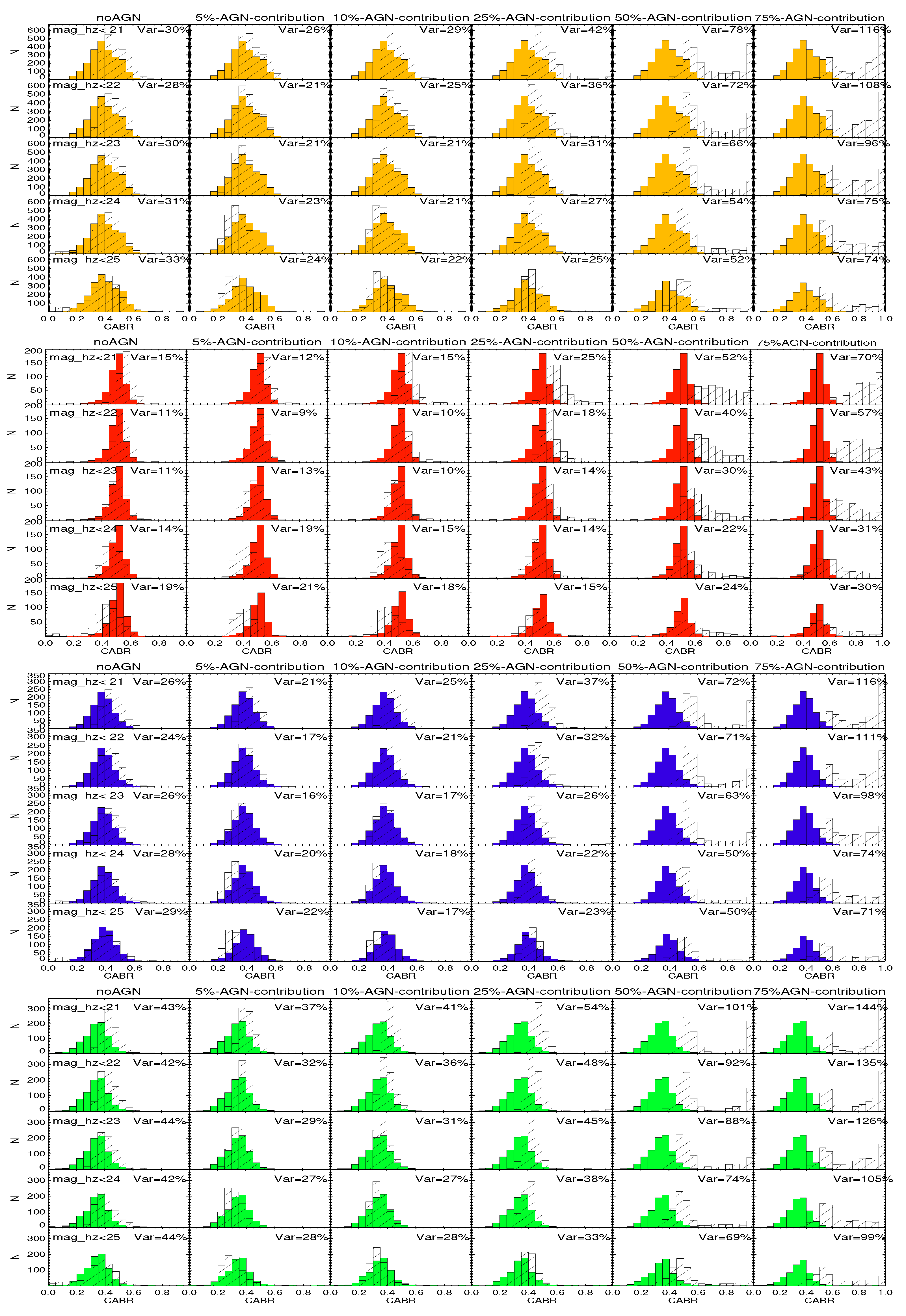
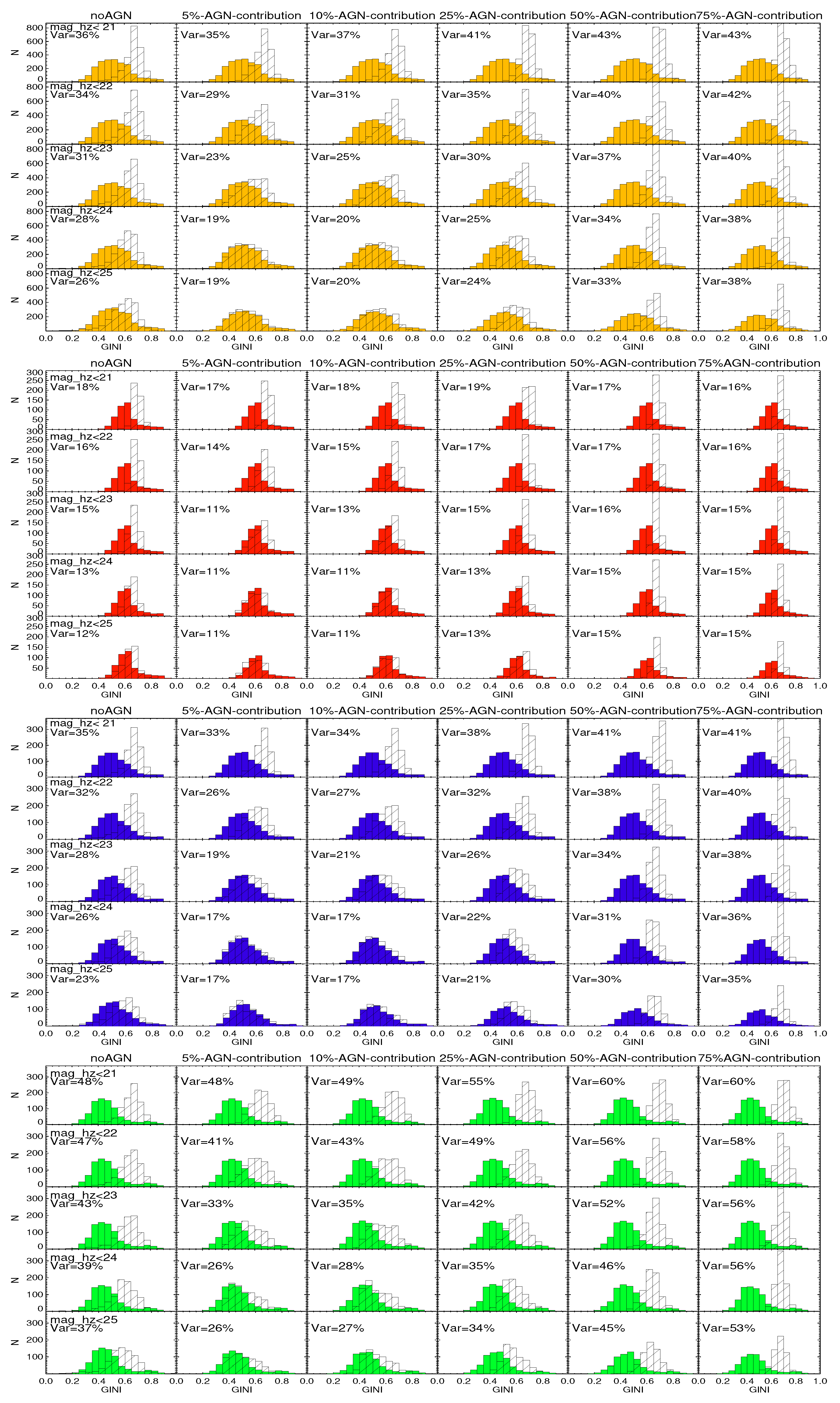
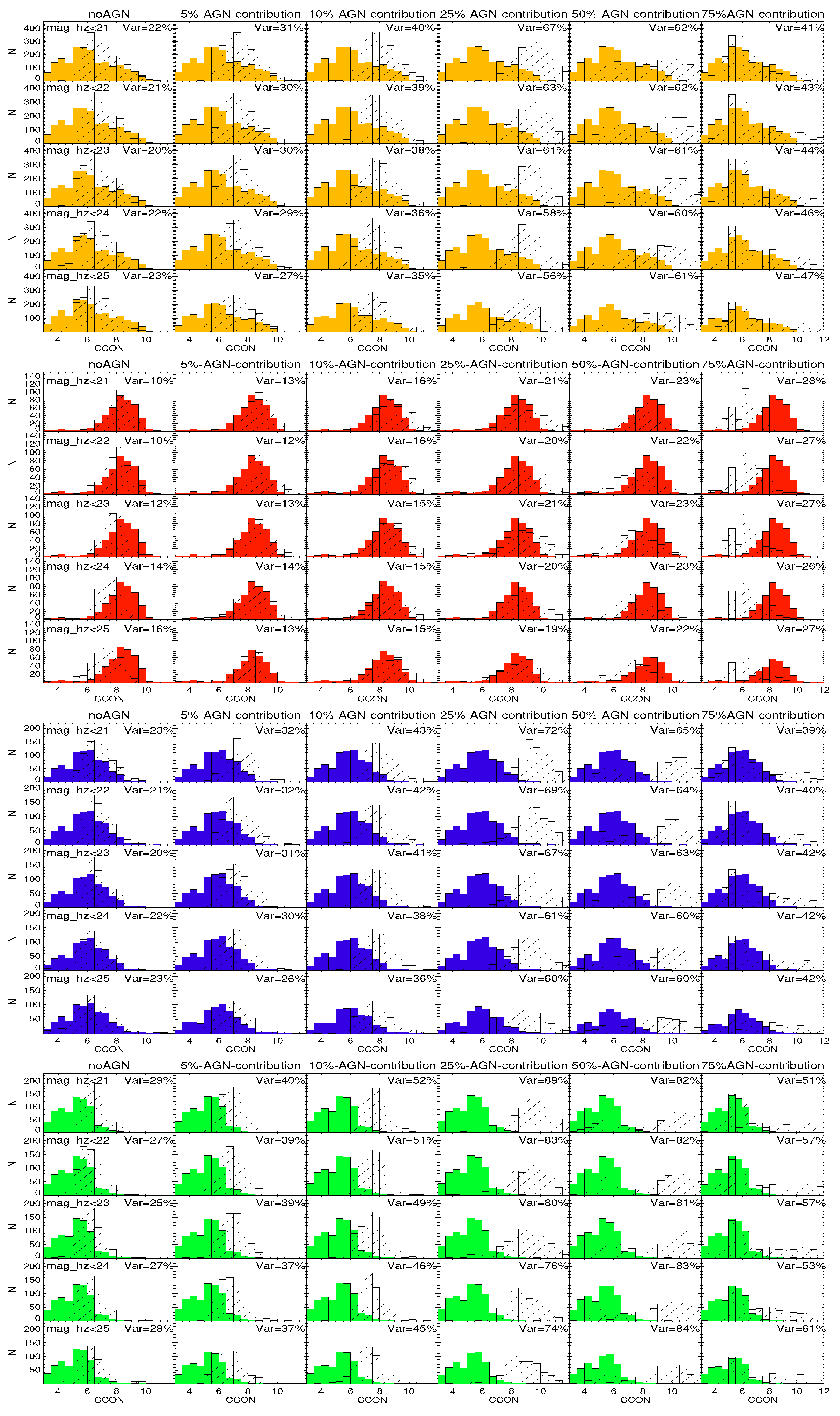

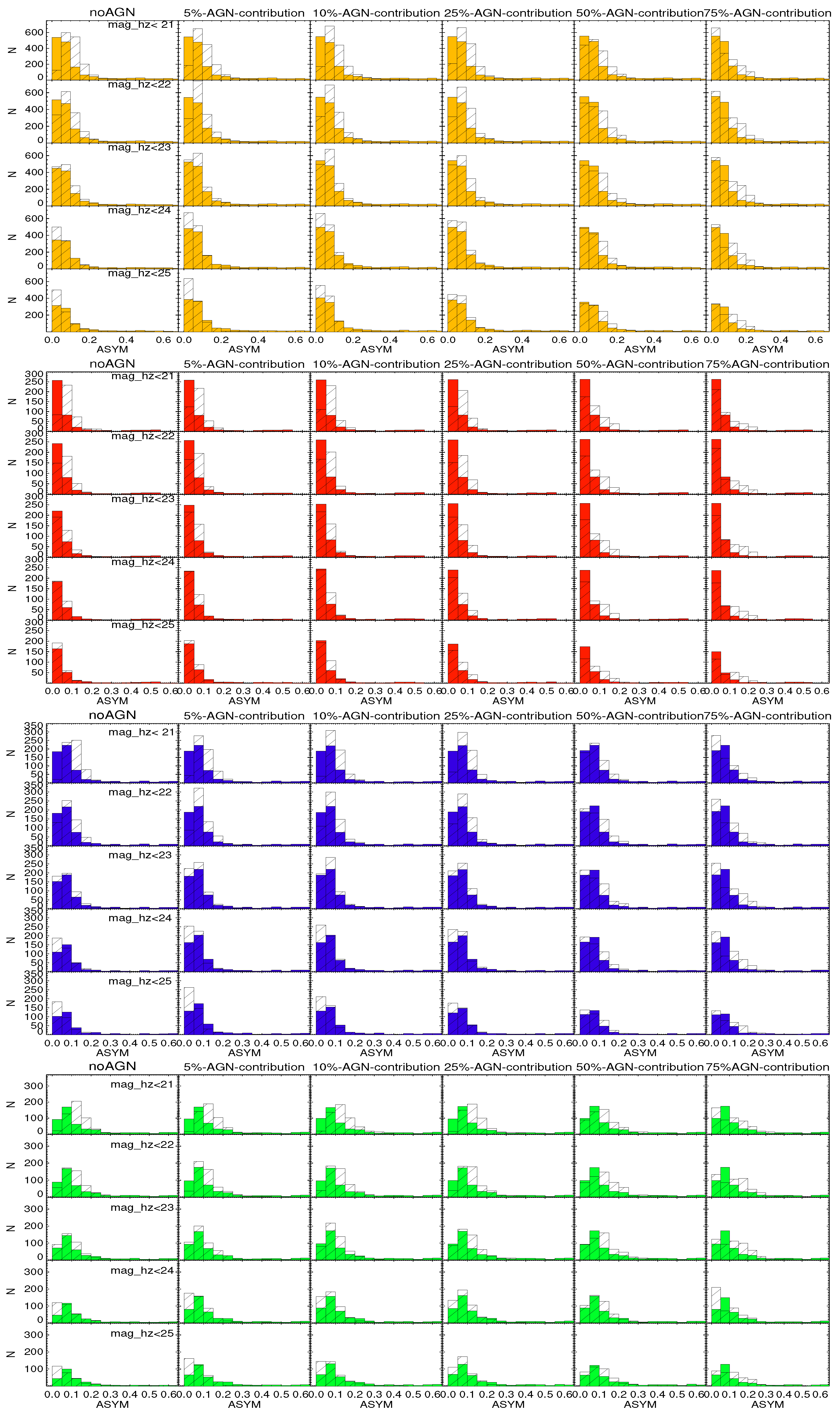
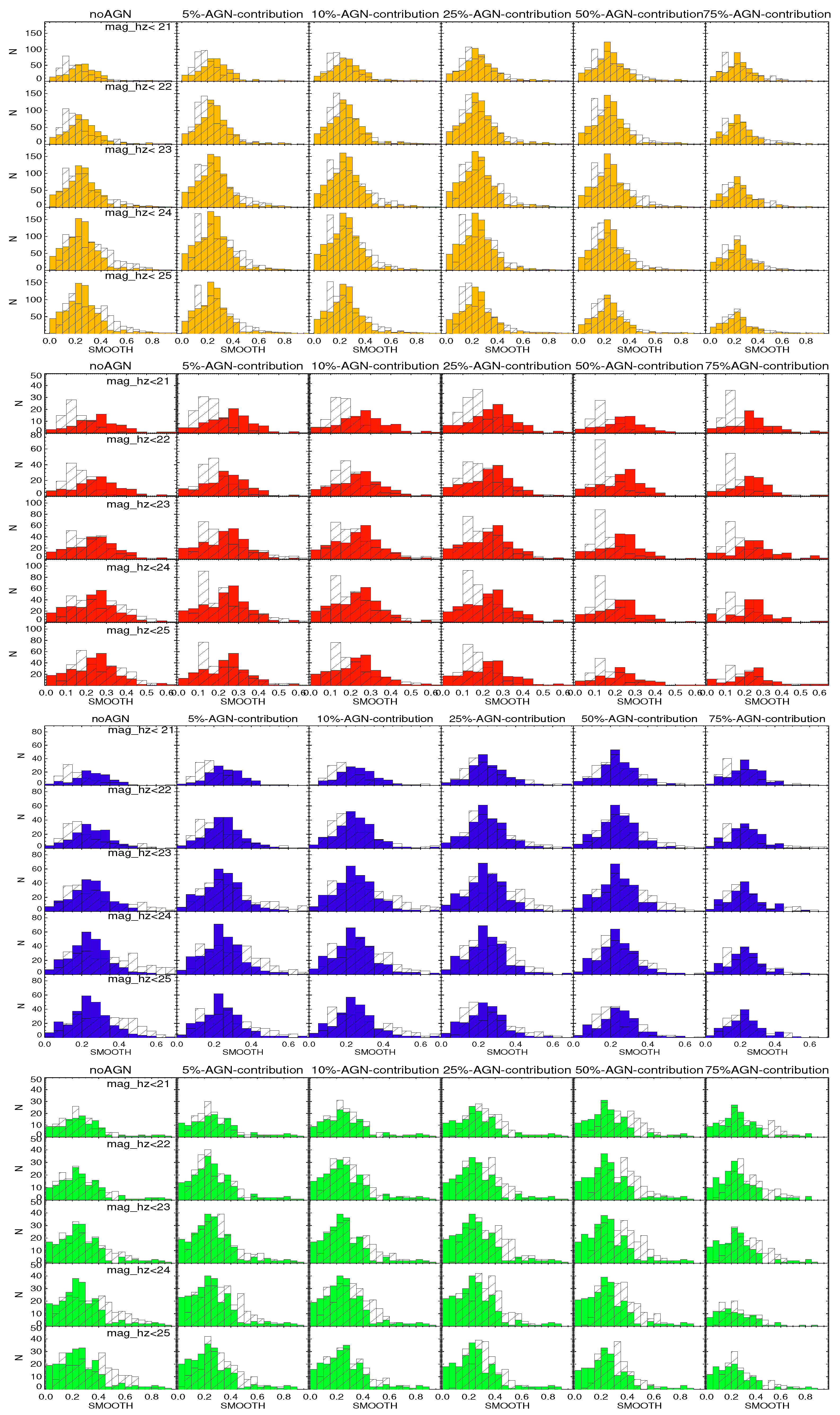
Appendix B. Comparing the Local-like AGN Sample with the COSMOS-like AGN Sample
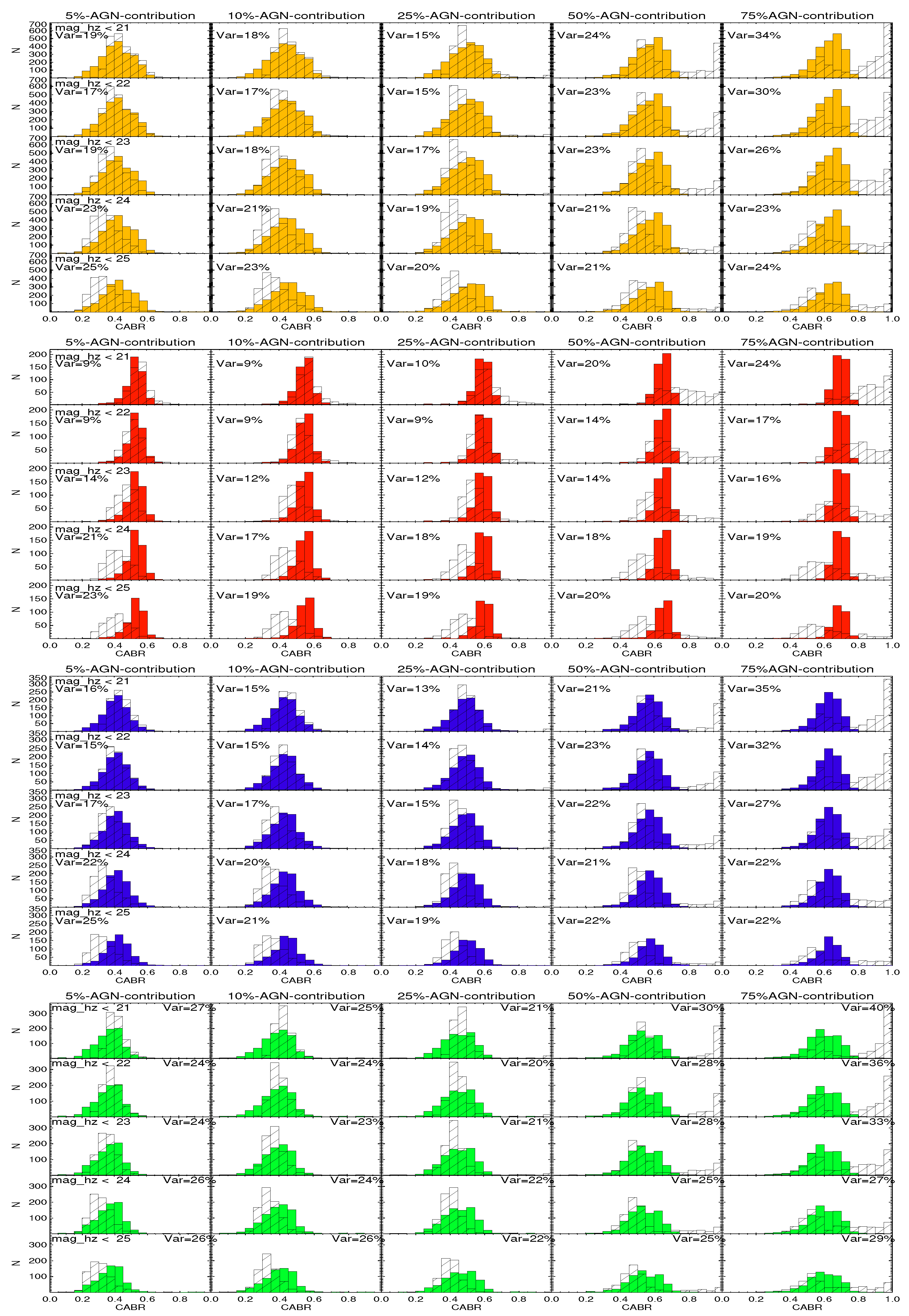
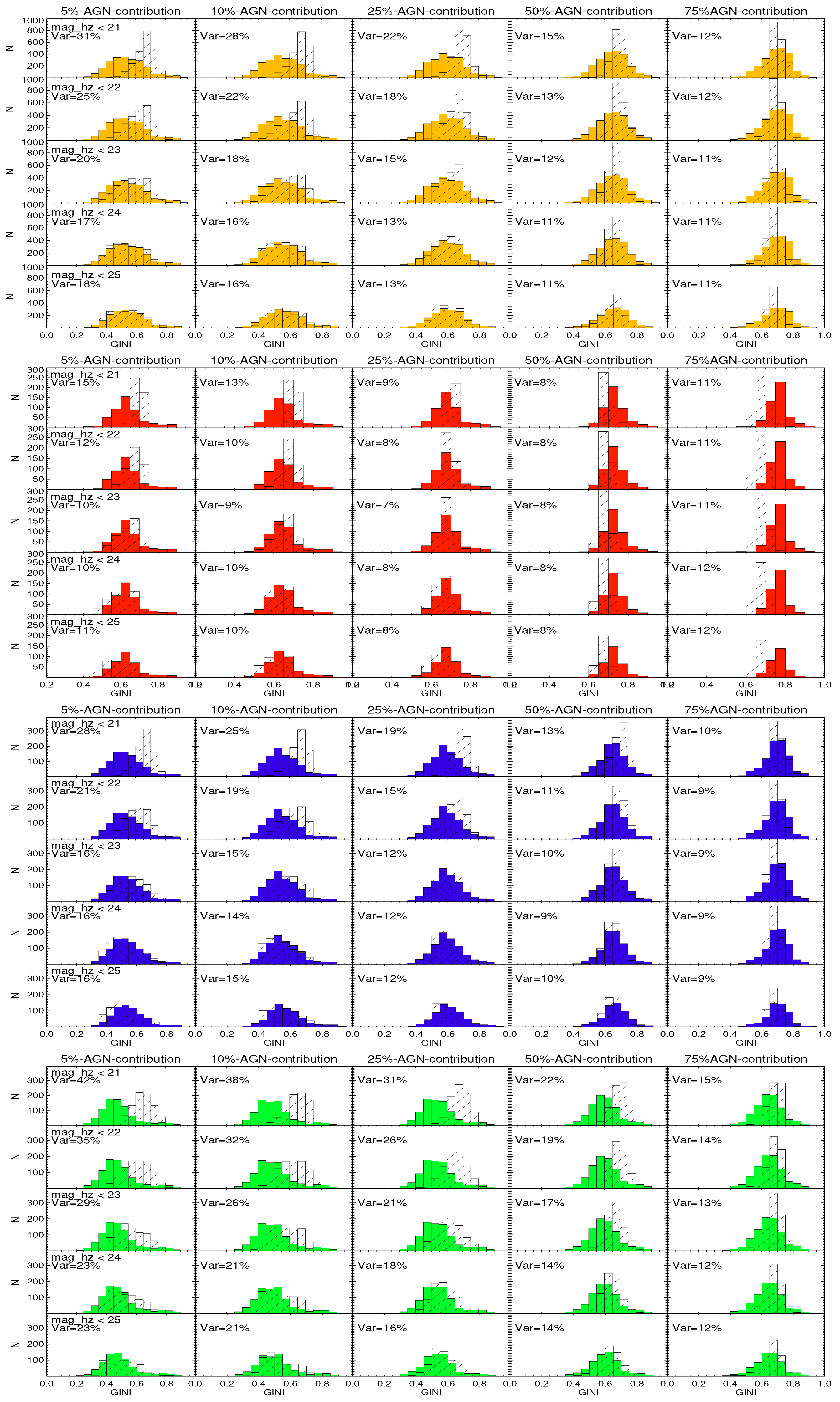

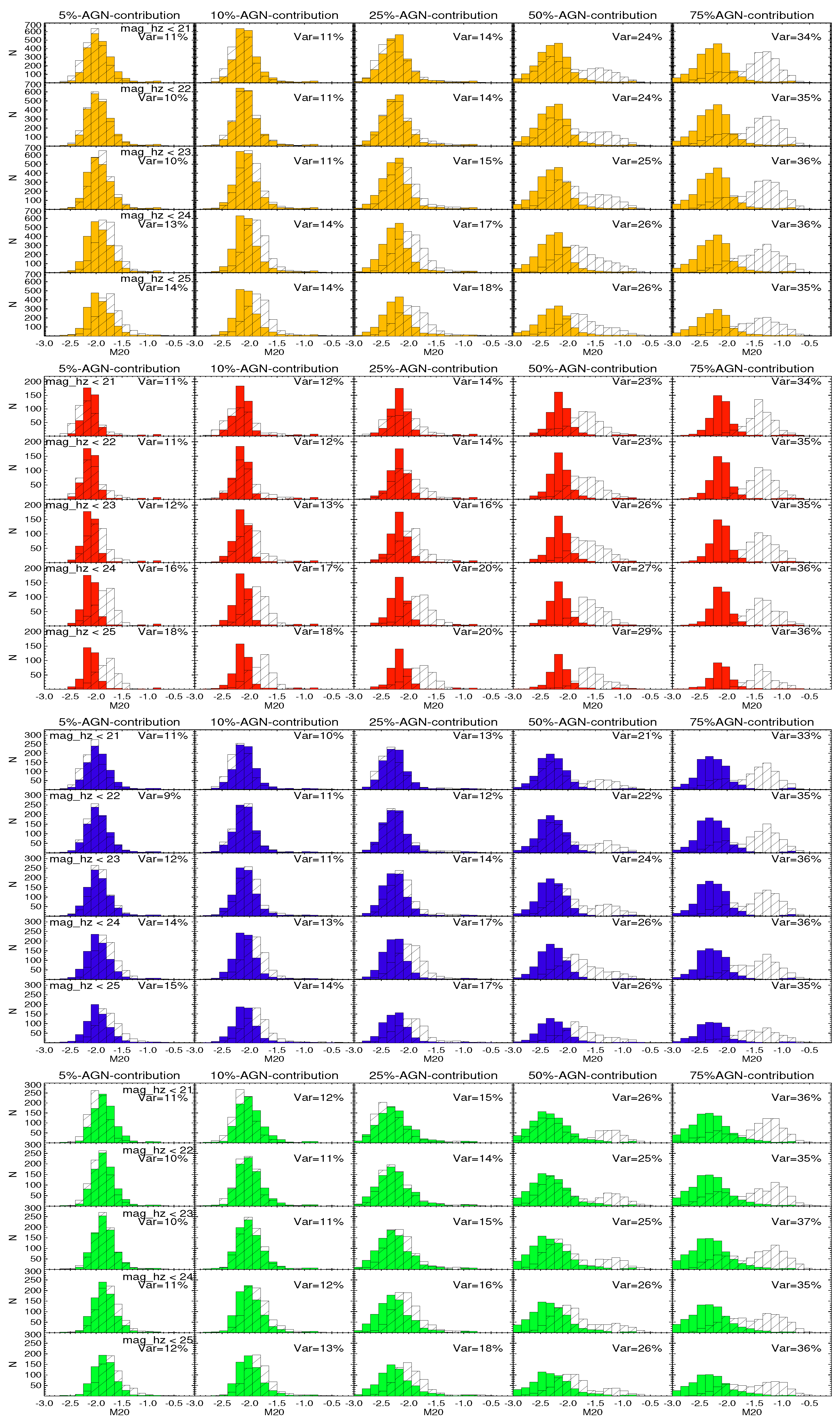
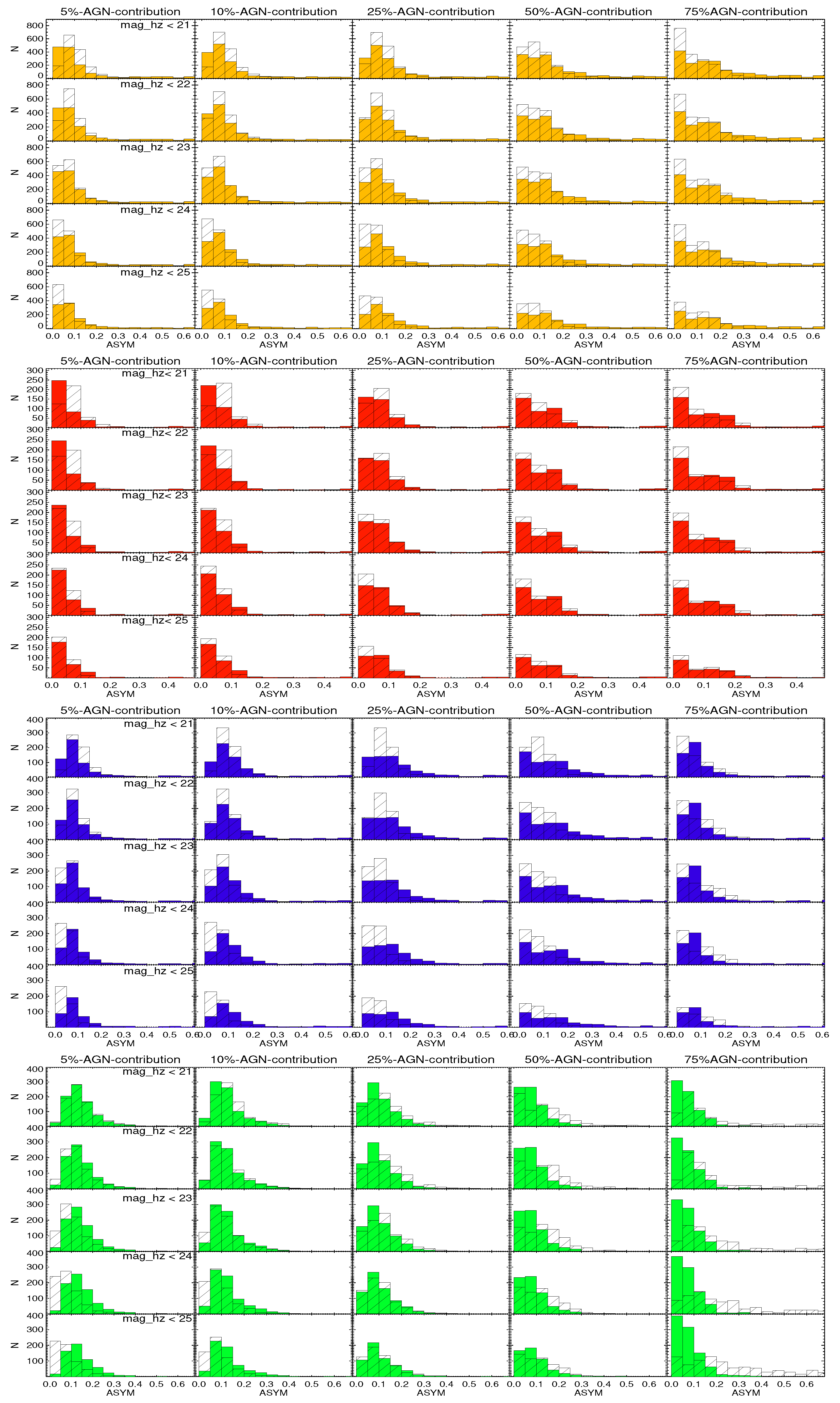
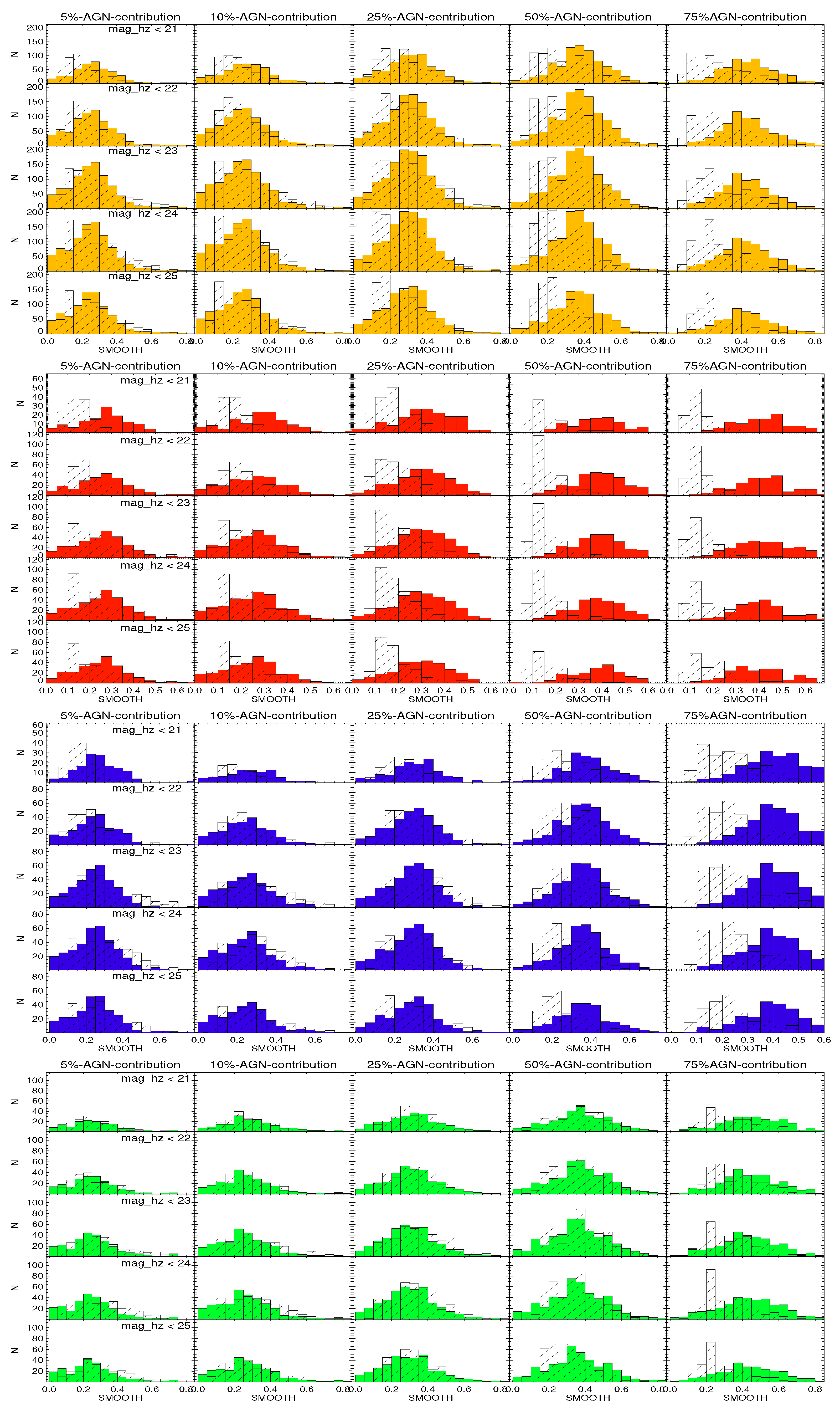
Appendix C. Comparing the COSMOS-like Sample with and Without AGN
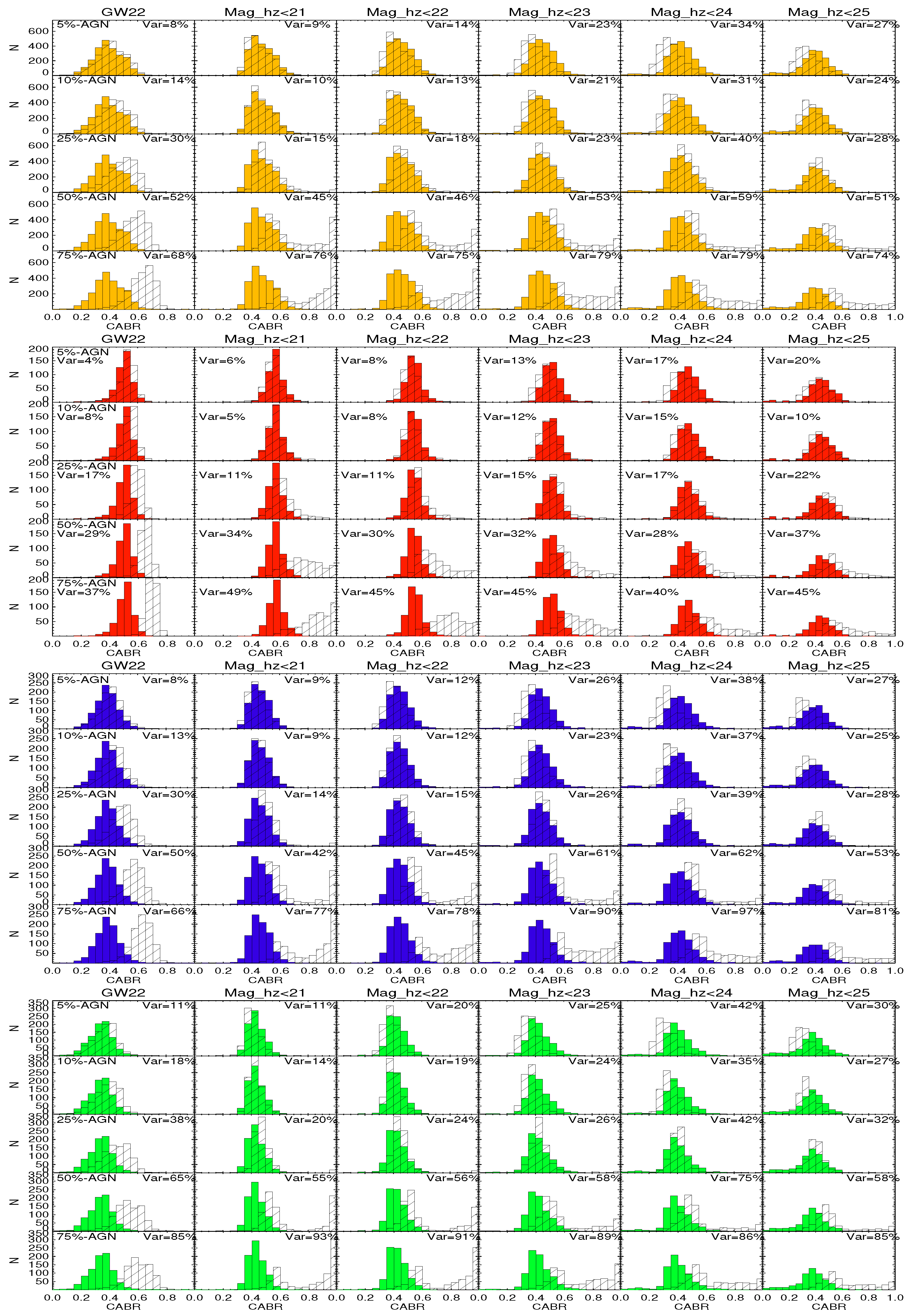
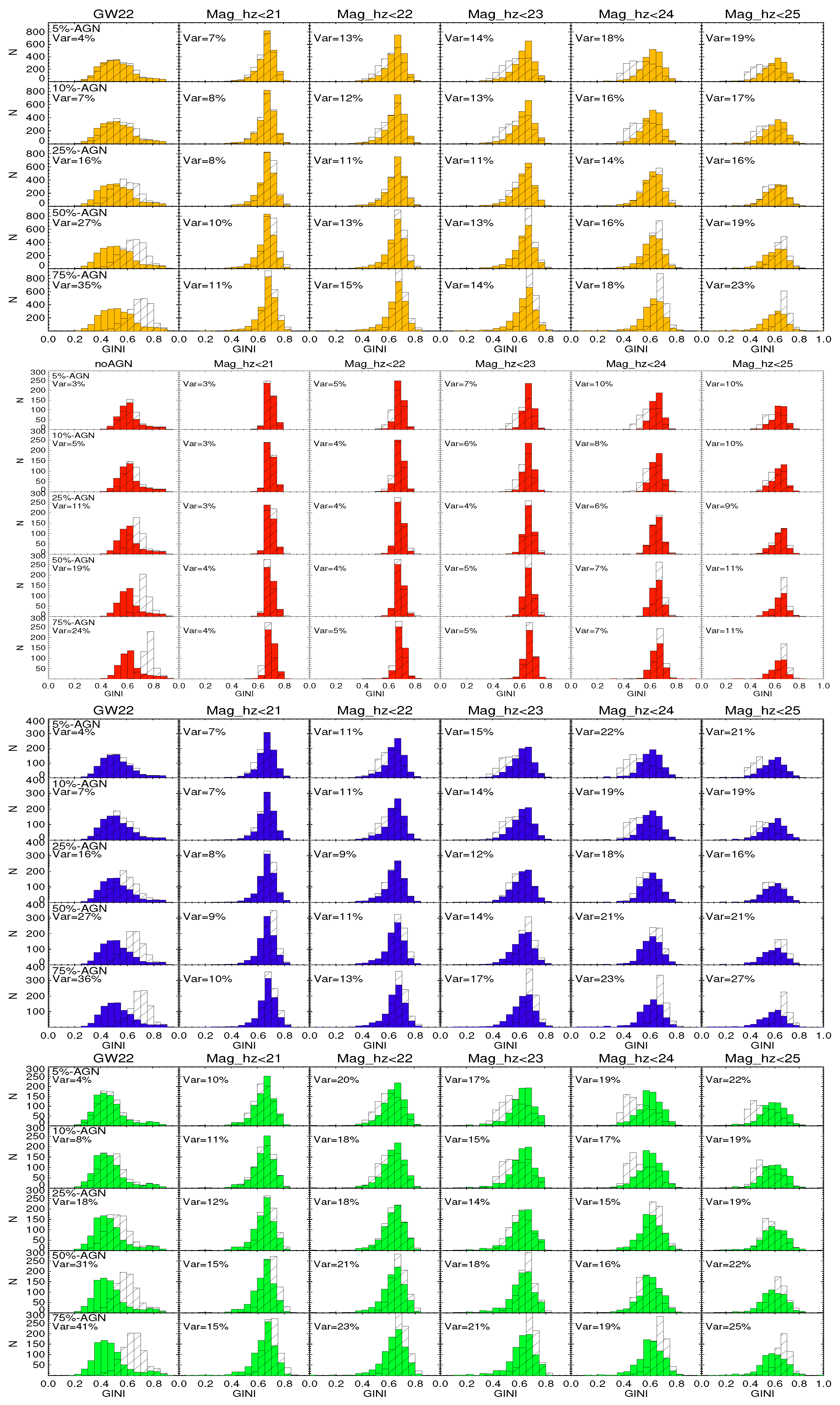
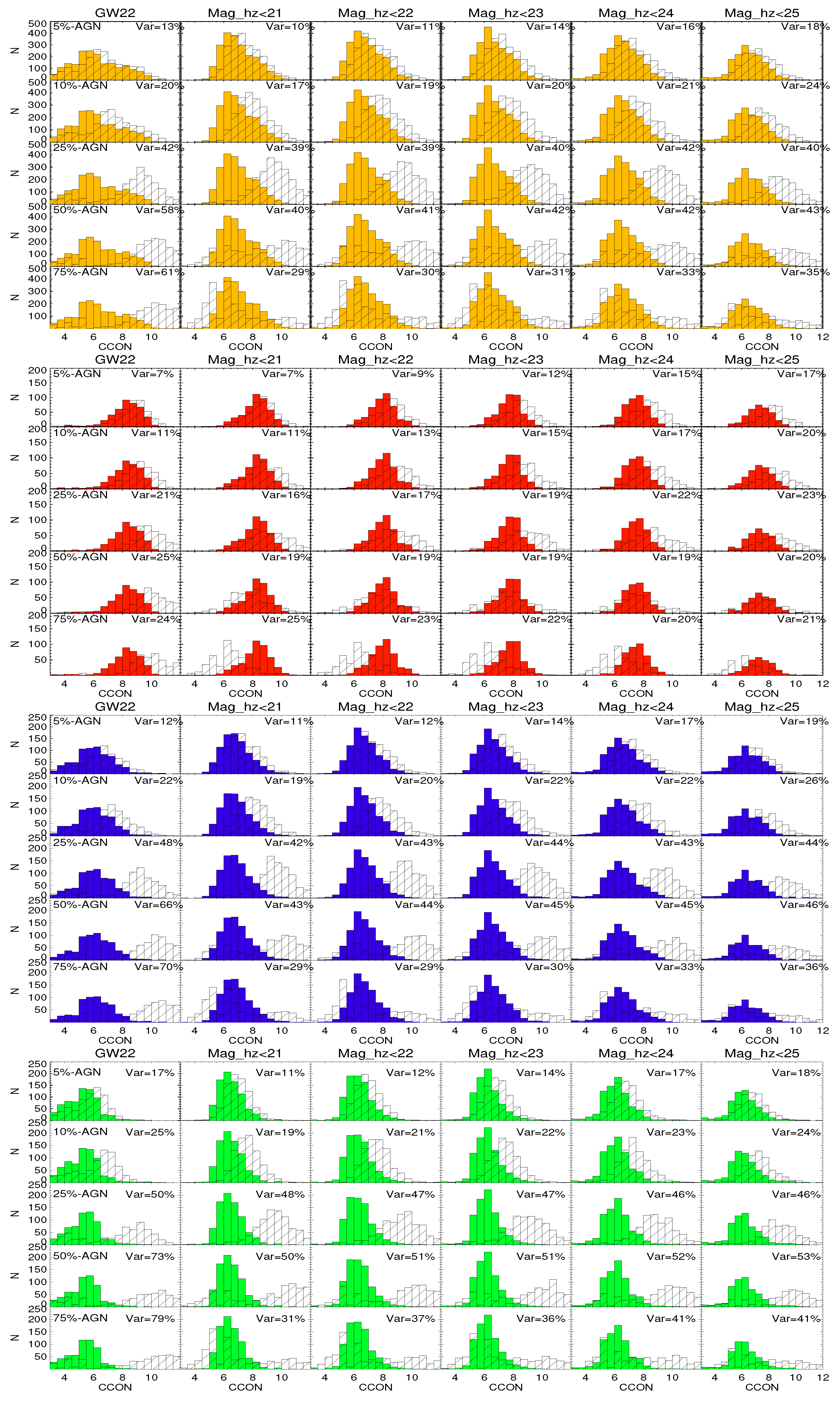
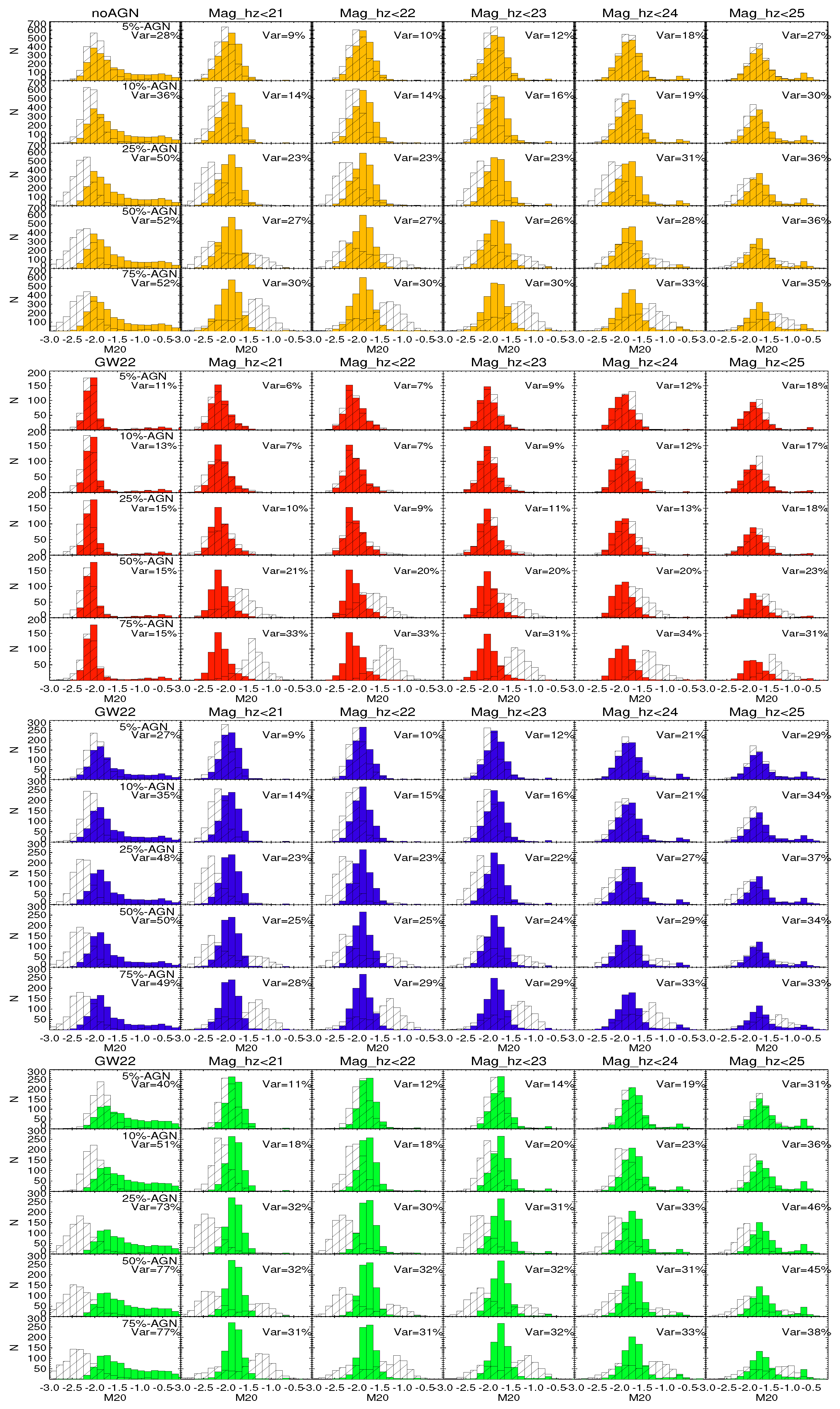
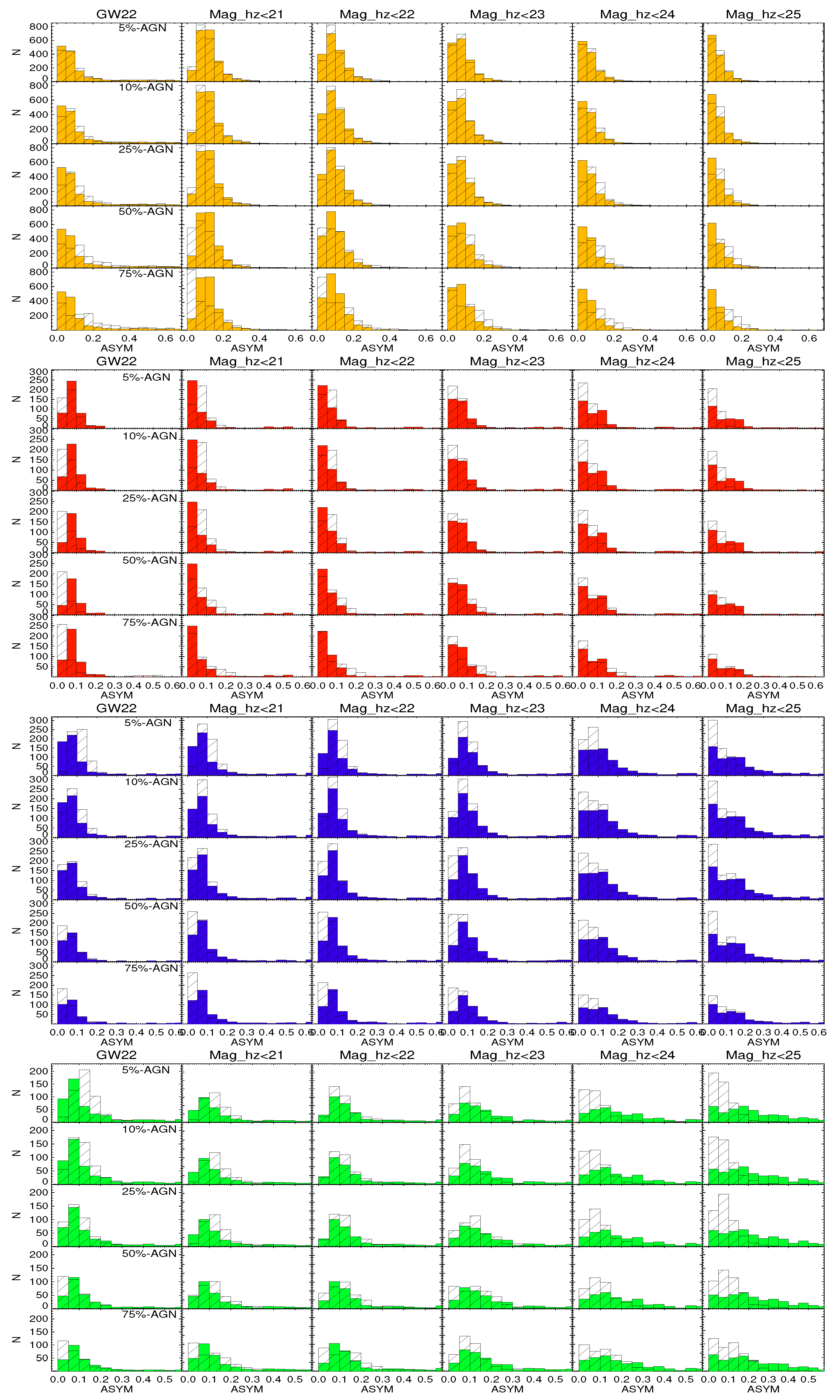
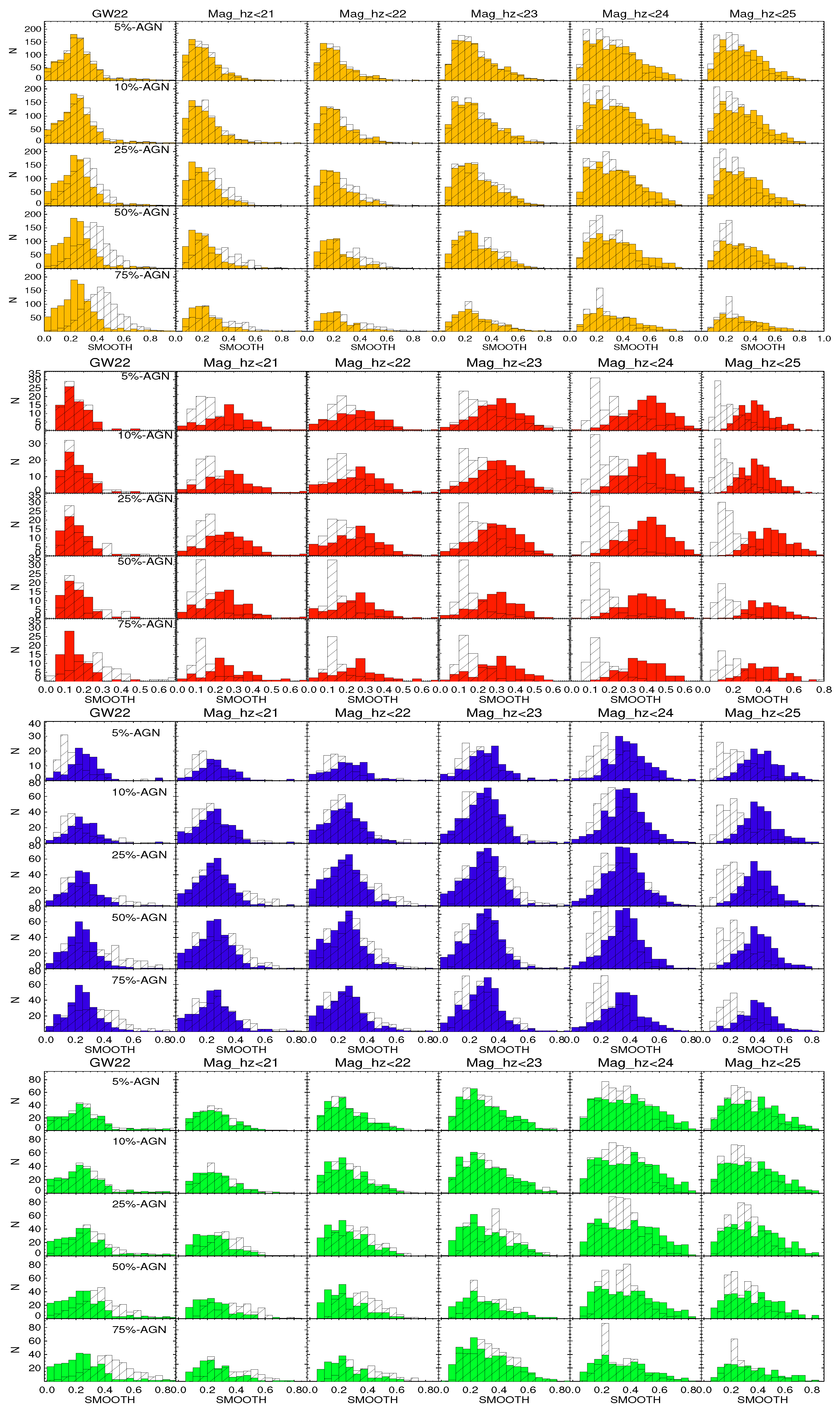
| 1 | https://www.mpa.mpa-garching.mpg.de/SDSS/ (accessed on 31 October 2008). |
References
- Beyoro-Amado, Z.; Pović, M.; Sánchez-Portal, M.; Tessema, S.B.; Bongiovanni, A.; Cepa, J.; Cervińo, M.; González-Serrano, J.I.; Nadolny, J.; Pérez Garcia, A.M.; et al. A morphological study of galaxies in ZwCl0024+1652, a galaxy cluster at redshift z ∼ 0.4. Mon. Not. R. Astron. Soc. 2019, 485, 1528. [Google Scholar] [CrossRef]
- Conselice, C.J. The evolution of galaxy structure over cosmic time. Annu. Rev. Astron. Astrophys. 2014, 52, 291–337. [Google Scholar] [CrossRef]
- Dimauro, P.; Daddi, E.; Shankar, F.; Cattaneo, A.; Huertas-Company, M.; Bernardi, M.; Caro, F.; Dupke, R.; Häußler, B.; Johnston, E.; et al. Coincidence between morphology and star formation activity through cosmic time: The impact of the bulge growth. Mon. Not. R. Astron. Soc. 2022, 513, 256–281. [Google Scholar] [CrossRef]
- Gabor, J.M.; Impey, C.D.; Jahnke, K.; Simmons, B.D.; Trump, J.R.; Koekemoer, A.M.; Brusa, M.; Cappelluti, N.; Schinnerer, E.; Smolčić, V.; et al. Active Galactic Nucleus Host Galaxy Morphologies in COSMOS. Astrophys. J. 2009, 691, 705–722. [Google Scholar] [CrossRef]
- Mei, S.; Hatch, N.A.; Amodeo, S.; Afanasiev, A.V.; De Breuck, C.; Stern, D.; Cooke, E.A.; Gonzalez, A.H.; Noirot, G.; Rettura, A.; et al. Morphology-density relation, quenching, and mergers in CARLA clusters and protoclusters at 1.4 < z < 2.8. Astron. Astrophys. 2023, 670, A58. [Google Scholar] [CrossRef]
- Pović, M.; Sánchez-Portal, M.; Pérez García, A.M.; Bongiovanni, A.; Cepa, J.; Alfaro, E.; Castaneda, H.; Lorenzo, M.F.; Gallego, J.; González-Serrano, J.I.; et al. OTELO Survey: Deep BVRI Broadband Photometry of the Groth Strip. II. Optical Properties of X-Ray Emitters. Astrophys. J. 2009, 706, 810. [Google Scholar] [CrossRef]
- Pović, M.; Sánchez-Portal, M.; Pérez García, A.M.; Bongiovanni, A.; Cepa, J.; Lorenzo, M.F.; Lara-López, M.A.; González-Serrano, J.I.; Alfaro, E.J. On the Anticorrelation Between Galaxy Light Concentration and X-ray-to-Optical Flux Ratio. Astrophys. J. 2009, 702, L51. [Google Scholar] [CrossRef][Green Version]
- Pović, M.; Huertas-Company, M.; Aguerri, J.A.L.; Márquez, I.; Masegosa, J.; Husillos, C.; Molino, A.; Cristóbal-Hornillos, D.; Perea, J.; Benítez, N.; et al. The ALHAMBRA survey: Reliable morphological catalogue of 22 051 early- and late-type galaxies. Mon. Not. R. Astron. Soc. 2013, 435, 3444–3461. [Google Scholar] [CrossRef]
- Pović, M.; Pérez García, A.M.; Sánchez-Portal, M.; Bongiovanni, A.; Cepa, J.; Lorenzo, M.F.; Lara-López, M.A.; Gallego, J.; Ederoclite, A.; Márquez, I.; et al. X-ray luminosity functions of different morphological and X-ray type AGN populations. Astron. Nachrichten 2013, 334, 288–299. [Google Scholar] [CrossRef]
- Lintott, C.J.; Schawinski, K.; Slosar, A.; Land, K.; Bamford, S.; Thomas, D.; Raddick, M.J.; Nichol, R.C.; Szalay, A.; Andreescu, D.; et al. Galaxy Zoo: Morphologies derived from visual inspection of galaxies from the Sloan Digital Sky Survey. Mon. Not. R. Astron. Soc. 2008, 389, 1179–1189. [Google Scholar] [CrossRef]
- Buta, R.J. Galaxy Morphology. In Planets, Stars and Stellar Systems; Springer: Dordrecht, The Netherlands, 2013; pp. 1–89. [Google Scholar]
- Mahoro, A.; Pović, M.; Nkundabakura, P.; Nyiransengiyumva, B.; Väisänen, P. Star formation in far-IR AGN and non-AGN galaxies in the green valley-II. Morphological analysis. Mon. Not. R. Astron. Soc. 2019, 485, 452–463. [Google Scholar] [CrossRef]
- Nair, P.B.; Abraham, R.G. A catalog of detailed visual morphological classifications for 14,034 galaxies in the sloan digital sky survey. Astrophys. J. Suppl. Ser. 2010, 186, 427–456. [Google Scholar] [CrossRef]
- Simmons, B.D.; Lintott, C.; Willett, K.W.; Masters, K.L.; Kartaltepe, J.S.; Häußler, B.; Kaviraj, S.; Krawczyk, C.; Kruk, S.J.; McIntosh, D.H.; et al. Galaxy Zoo: Quantitative visual morphological classifications for 48,000 galaxies from CANDELS. Mon. Not. R. Astron. Soc. 2017, 464, 4420–4447. [Google Scholar] [CrossRef]
- Willett, K.W.; Galloway, M.A.; Bamford, S.P.; Lintott, C.J.; Masters, K.L.; Scarlata, C.; Simmons, B.D.; Beck, M.; Cardamone, C.N.; Cheung, E.; et al. Galaxy Zoo: Morphological classifications for 120, 000 galaxies in HST legacy imaging. Mon. Not. R. Astron. Soc. 2017, 464, 4176–4203. [Google Scholar] [CrossRef]
- Zywucka, N.; Koziel Wierzbowska, D.; Goyal, A. Catalogue with visual morphological classification of 32,616 radio galaxies with optical hosts. Proc. Int. Astron. Union 2021, 356, 361–363. [Google Scholar]
- Jiménez-Teja, Y.; Benítez, N. A New Tool for Image Analysis Based on Chebyshev Rational Functions: CHEF Functions. Astrophys. J. 2012, 745, 150. [Google Scholar] [CrossRef]
- Nadolny, J.; Bongiovanni, Á.; Cepa, J.; Cerviño, M.; García, A.M.P.; Pović, M.; Martínez, R.P.; Sánchez-Portal, M.; de Diego, J.A.; Pintos-Castro, I.; et al. The OTELO survey as a morphological probe. Last ten Gyr of galaxy evolution. The mass-size relation up to z = 2. Astron. Astrophys. 2021, 647, A89. [Google Scholar] [CrossRef]
- Peng, C.Y.; Ho, L.C.; Impey, C.D.; Rix, H.-W. Detailed Structural Decomposition of Galaxy Images. Astrophys. J. 2002, 124, 266–293. [Google Scholar] [CrossRef]
- Peng, C.Y.; Ho, L.C.; Impey, C.D.; Rix, H.-W. Detailed Decomposition of Galaxy Images. II. Beyond Axisymmetric Models. Astron. J. 2010, 139, 2097–2129. [Google Scholar] [CrossRef]
- Sersic, J.L. The southern barred spiral NGC 2442. Astron. Astrophys. Suppl. Ser. 1993, 98, 21–27. [Google Scholar]
- Simard, L.; Mendel, J.T.; Patton, D.R.; Ellison, S.L.; McConnachie, A.W. A Catalog of Bulge+disk Decompositions and Updated Photometry for 1.12 Million Galaxies in the Sloan Digital Sky Survey. Astrophys. J. Suppl. Ser. 2011, 196, 11. [Google Scholar] [CrossRef]
- Cutler, S.E.; Whitaker, K.E.; Mowla, L.A.; Brammer, G.B.; van der Wel, A.; Marchesini, D.; van Dokkum, P.G.; Momcheva, I.G.; Song, M.; Akhshik, M.; et al. Diagnosing DASH: A catalogue of structural properties for the COSMOS-DASH survey. Astrophys. J. 2022, 925, 34. [Google Scholar] [CrossRef]
- Vika, M.; Bamford, S.P.; Häußler, B.; Rojas, A.L. MegaMorph multi-wavelength measurement of galaxy structure: Physically meaningful bulge-disc decomposition of galaxies near and far. Mon. Not. R. Astron. Soc. 2014, 444, 3603–3621. [Google Scholar] [CrossRef]
- Chugunov, I.V.; Marchuk, A.A.; Mosenkov, A.V.; Savchenko, S.S.; Shishkina, E.V.; Chazov, M.I.; Nazarova, A.E.; Skryabina, M.N.; Smirnova, P.I.; Smirnov, A.A. Galaxies decomposition with spiral arms-I: 29 galaxies from S4G. Mon. Not. R. Astron. Soc. 2024, 527, 9605. [Google Scholar] [CrossRef]
- Marchuk, A.A.; Chugunov, I.V.; Gontcharov, G.A.; Mosenkov, A.V.; Il’in, V.B.; Savchenko, S.S.; Smirnov, A.A.; Poliakov, D.M.; Seguine, J.; Chazov, M.I. Galaxies decomposition with spiral arms-II. A multiwavelength case study of M51. Mon. Not. R. Astron. Soc. 2024, 528, 1276–1295. [Google Scholar] [CrossRef]
- Abraham, R.G.; Bergh, S.; Glazebrook, K.; Ellis, R.S.; Santiago, B.X.; Surma, P.; Griffiths, R.E. The Morphologies of Distant Galaxies. II. Classifications from the Hubble Space Telescope Medium Deep Survey. Astrophys. J. Suppl. Ser. 1996, 107, 1. [Google Scholar] [CrossRef]
- Abraham, R.G.; Valdes, F.; Yee, H.K.C.; van den Bergh, S. The Morphologies of Distant Galaxies. I. an Automated Classification System. Astrophys. J. 1994, 432, 75. [Google Scholar] [CrossRef]
- Conselice, C.J.; Bershady, M.A.; Dickinson, M.; Papovich, C. A Direct Measurement of Major Galaxy Mergers at z ≤ 3. Astron. J. 2003, 126, 1183. [Google Scholar] [CrossRef]
- Conselice, C.J.; Bershady, M.A.; Jangren, A. The asymmetry of galaxies: Physical morphology for nearby and high-redshift galaxies. Astrophys. J. 2000, 529, 886–910. [Google Scholar] [CrossRef]
- Huertas-Company, M.; Rouan, D.; Tasca, L.; Soucail, G.; Le Fèvre, O. A robust morphological classification of high-redshift galaxies using support vector machines on seeing-limited images. I. Method description. Astron. Astrophys. 2008, 478, 971–980. [Google Scholar] [CrossRef]
- Mukundan, K.; Nair, P.; Bailin, J.; Li, W. Automating galaxy morphology classification using k-nearest neighbours and non-parametric statistics. Mon. Not. R. Astron. Soc. 2024, 533, 292–312. [Google Scholar] [CrossRef]
- Nersesian, A.; Zibetti, S.; D’eUgenio, F.; Baes, M. Non-parametric galaxy morphology from stellar and nebular emission with the CALIFA sample. Astron. Astrophys. 2023, 673, A63. [Google Scholar] [CrossRef]
- Abraham, R.G.; van den Bergh, S.; Nair, P. A new approach to galaxy morphology. I. Analysis of the Sloan Digital Sky Survey early data release. Astrophys. J. 2003, 588, 218. [Google Scholar] [CrossRef]
- Lotz, J.M.; Primack, J.; Madau, P. A New Nonparametric Approach to Galaxy Morphological Classification. Astron. J. 2004, 128, 163–182. [Google Scholar] [CrossRef]
- Bershady, M.A.; Jangren, A.; Conselice, C.J. Structural and photometric classification of galaxies. I. Calibration based on a nearby galaxy sample. Astron. J. 2000, 119, 2645. [Google Scholar]
- Pović, M.; Márquez, I.; Masegosa, J.; Perea, J.; Olmo, A.; Simpson, C.; Aguerri, J.A.L.; Ascaso, B.; Jiménez-Teja, Y.; López-Sanjuan, C.; et al. The impact from survey depth and resolution on the morphological classification of galaxies. Mon. Not. R. Astron. Soc. 2015, 453, 1644–1668. [Google Scholar] [CrossRef]
- Getachew-Woreta, T.; Pović, M.; Masegosa, J.; Perea, J.; Beyoro-Amado, Z.; Márquez, I. Effect of AGN on the morphological properties of their host galaxies in the local Universe. Mon. Not. R. Astron. Soc. 2022, 514, 607. [Google Scholar] [CrossRef]
- Pintos-Castro, I.; Pović, M.; Sanchez-Portal, M.I.; Cepa, J.; Altieri, B.; Bongiovanni, Á.; Duc, P.A.; Ederoclite, A.; Oteo, I.; García, A.M.P.; et al. Multi-wavelength landscape of the young galaxy cluster RXJ 1257.2+4738 at z = 0.866. II. Morphological properties. Astron. Astrophys. 2016, 529, A108. [Google Scholar] [CrossRef]
- Pović, M.; Sánchez-Portal, M.; Pérez García, A.M.; Bongiovanni, A.; Cepa, J.; Huertas-Company, M.; Lara-López, M.A.; Lorenzo, M.F.; Ederoclite, A.; Alfaro, E.; et al. AGN-host galaxy connection: Morphology and colours of X-ray selected AGN at z ≤ 2. Astron. Astrophys. 2012, 541, A118. [Google Scholar] [CrossRef]
- Çakir, U.; Buck, T. MEGS: Morphological Evaluation of Galactic Structure-Principal component analysis as a galaxy morphology model. Astron. Astrophys. 2024, 691, 320. [Google Scholar] [CrossRef]
- Cavanagh, M.K.; Bekki, K.; Groves, B.A. Morphological classification of galaxies with deep learning: Comparing 3-way and 4-way CNNs. Mon. Not. R. Astron. Soc. 2021, 506, 659–676. [Google Scholar] [CrossRef]
- Cheng, X.-P.; An, T.; Frey, S.; Hong, X.Y.; He, X.; Kellermann, K.I.; Lister, M.L.; Lao, B.Q.; Li, X.F.; Mohan, P.; et al. Compact Bright Radio-loud AGNs. III. A Large VLBA Survey at 43 GHz. Astrophys. J. Suppl. Ser. 2020, 247, 57. [Google Scholar] [CrossRef]
- de Diego, J.A.; Nadolny, J.; Bongiovanni, Á.; Cepa, J.; Pović, M.; García, A.M.P.; Torres, C.P.P.; Lara-López, M.A.; Cerviño, M.; Martínez, R.P.; et al. Galaxy classification: Deep learning on the OTELO and COSMOS databases. Astron. Astrophys. 2020, 638, 134. [Google Scholar] [CrossRef]
- de Diego, J.A.; Nadolny, J.; Bongiovanni, Á.; Cepa, J.; Lara-López, M.A.; Gallego, J.; Cerviño, M.; Sánchez-Portal, M.; González-Serrano, J.I.; Alfaro, E.J.; et al. Nonsequential neural network for simultaneous, consistent classification, and photometric redshifts of OTELO galaxies. Astron. Astrophys. 2021, 655A, 56. [Google Scholar] [CrossRef]
- Domínguez Sánchez, H.; Margalef, B.; Bernardi, M.; Huertas-Company, M. SDSS-IV DR17: Final release of MaNGA PyMorph photometric and deep-learning morphological catalogues. Mon. Not. R. Astron. Soc. 2022, 509, 4024–4036. [Google Scholar] [CrossRef]
- Martin, G.; Kaviraj, S.; Hocking, A.; Read, S.C.; Geach, J.E. Galaxy morphological classification in deep-wide surveys via unsupervised machine learning. Mon. Not. R. Astron. Soc. 2020, 491, 1408–1426. [Google Scholar] [CrossRef]
- Sazonov, S.; Gilfanov, M.; Medvedev, P.; Yao, Y.; Khorunzhev, G.; Semena, A.; Sunyaev, R.; Burenin, R.; Lyapin, A.; Meshcheryakov, A.; et al. First tidal disruption events discovered by SRG/eROSITA: X-ray/optical properties and X-ray luminosity function at z < 0.6. Astron. Astrophys. 2021, 649, 1. [Google Scholar]
- Urrutia-Viscarra, F.; Méndez-Abreu, J.; de Souza, R.S.; Smith, A.B.; Johnson, C.D.; Lee, E.F.; Martínez-González, P.; Chen, H.-L.; O’Connell, R.W.; Thompson, K.L.; et al. The Impact of AGN Feedback on Galaxy Formation: A Multi-Wavelength Study. Astrophys. J. 2023, 935, 125–145. [Google Scholar]
- Vavilova, I.B.; Dobrycheva, D.V.; Vasylenko, M.Y.; Elyiv, A.A.; Melnyk, O.V.; Khramtsov, V. Machine learning technique for morphological classification of galaxies from the SDSS. I. Photometry-based approach. Astron. Astrophys. 2021, 648, A122. [Google Scholar] [CrossRef]
- Dubois, Y.; Peirani, S.; Pichon, C.; Devriendt, J.; Gavazzi, R.; Welker, C.; Volonteri, M. HORIZON-AGN simulation: Morphological diversity of galaxies promoted by AGN feedback. Mon. Not. R. Astron. Soc. 2016, 463, 3948–3964. [Google Scholar] [CrossRef]
- Kauffmann, G.; Heckman, T.M.; Tremonti, C.; Brinchmann, J.; Charlot, S.; White, S.D.M.; Ridgway, S.E.; Brinkmann, J.; Fukugita, M.; Hall, P.B.; et al. The host galaxies of active galactic nuclei. Mon. Not. R. Astron. Soc. 2003, 346, 1055–1077. [Google Scholar] [CrossRef]
- Pierce, C.M.; Lotz, J.M.; Primack, J.R.; Rosario, D.J.V.; Griffith, R.L.; Conselice, C.J.; Faber, S.M.; Koo, D.C.; Coil, A.L.; Salim, S.; et al. The effects of an active galactic nucleus on host galaxy colour and morphology measurements. Mon. Not. R. Astron. Soc. 2010, 405, 718–734. [Google Scholar] [CrossRef]
- Pierce, C.M.; Lotz, J.M.; Laird, E.S.; Lin, L.; Nandra, K.; Primack, J.R.; Faber, S.M.; Barmby, P.; Park, S.Q.; Willner, S.P.; et al. AEGIS: Host Galaxy Morphologies of X-Ray-selected and Infrared-selected Active Galactic Nuclei at 0.2 ≤z < 1.2. Astrophys. J. 2007, 660, L19–L22. [Google Scholar]
- Choi, Y.; Woo, J.; Park, C. Environmental Dependence of Active Galactic Nucleus Activity. I. The Effects of Host Galaxy. Astrophys. J. 2009, 699, 1679–1689. [Google Scholar] [CrossRef]
- Hickox, R.C.; Jones, C.; Forman, W.R.; Murray, S.S.; Kochanek, C.S.; Eisenstein, D.; Jannuzi, B.T.; Dey, A.; Brown, M.J.I.; Stern, D.; et al. Host Galaxies, Clustering, Eddington Ratios, and Evolution of Radio, X-Ray, and Infrared-Selected AGNs. Astrophys. J. 2009, 696, 891–919. [Google Scholar] [CrossRef]
- Cardamone, C.N.; Urry, C.M.; Schawinski, K.; Treister, E.; Brammer, G.; Gawiser, E. Dust-corrected colors reveal bimodality in the host-galaxy colors of active galactic nuclei at z ∼ 1. Astrophys. J. 2010, 721, L38–L42. [Google Scholar] [CrossRef]
- Trump, J.R.; Sun, M.; Zeimann, G.R.; Luck, C.; Bridge, J.S.; Grier, C.J.; Hagen, A.; Juneau, S.; Montero-Dorta, A.; Rosario, D.J.; et al. The biases of optical line-ratio selection for active galactic nuclei and the intrinsic relationship between black hole accretion and galaxy star formation. Astrophys. J. 2015, 811, 26. [Google Scholar] [CrossRef]
- Scoville, N. Merging Galaxies in COSMOS and Galaxy Evolution. Astron. Astrophys. 2010, 215, 33802. [Google Scholar]
- Parekh, V.; Heyden, K.v.; Ferrari, C.; Angus, G.; Holwerda, B. Morphology parameters: Substructure identification in X-ray galaxy clusters. Astron. Astrophys. 2015, 575, A127. [Google Scholar] [CrossRef]
- Baldwin, J.A.; Phillips, M.M.; Terlevich, R. Classification parameters for the emission-line spectra of extragalactic objects. Publ. Astron. Soc. Pac. 1981, 93, 5. [Google Scholar] [CrossRef]
- Mosleh, M.; Williams, R.J.; Franx, M. On The Robustness of z = 0-1 Galaxy Size Measurements Through Model and Non-Parametric Fits. Astrophys. J. 2013, 777, 117. [Google Scholar] [CrossRef]
- Scoville, N.; Aussel, H.; Brusa, M.; Capak, P.; Carollo, C.M.; Elvis, M.; Giavalisco, M.; Guzzo, L.; Hasinger, G.; Impey, C.; et al. The cosmic evolution survey (COSMOS): Overview. Astrophys. J. Suppl. Ser. 2007, 172, 1–8. [Google Scholar] [CrossRef]
- Koekemoer, A.M.; Aussel, H.; Calzetti, D.; Capak, P.; Giavalisco, M.; Kneib, J.; Leauthaud, A.; Le Fevre, O.; McCracken, H.J.; Massey, R.; et al. The COSMOS Survey: Hubble Space Telescope Advanced Camera for Surveys Observations and Data Processing. Astrophys. J. Suppl. Ser. 2007, 172, 196–202. [Google Scholar] [CrossRef]
- Leauthaud, A.; Massey, R.; Kneib, J.P.; Rhodes, J.; Johnston, D.E.; Capak, P.; Heymans, C.; Ellis, R.S.; Koekemoer, A.M.; Le Fevre, O.; et al. Weak gravitational lensing with COSMOS: Galaxy selection and shape measurements. Astrophys. J. Suppl. Ser. 2007, 172, 219–238. [Google Scholar] [CrossRef]
- Ilbert, O.; Capak, P.; Salvato, M.; Aussel, H.; McCracken, H.J.; Sanders, D.B.; Scoville, N.; Kartaltepe, J.; Arnouts, S.; Floc’h, E.L.; et al. Cosmos Photometric Redshifts with 30-Bands for 2-deg 2. Astrophys. J. 2009, 690, 1236. [Google Scholar] [CrossRef]
- Chang, C.C.; Lin, C.J. LIBSVM: A library for support vector machines. ACM Trans. Intell. Syst. Technol. (TIST) 2011, 2, 27. [Google Scholar] [CrossRef]
- Bertin, E.; Arnouts, S. SExtractor: Software for source extraction. Astron. Astrophys. Suppl. Ser. 1996, 117, 393. [Google Scholar] [CrossRef]
- Moffat, A.F.J. A Theoretical Investigation of Focal Stellar Images in the Photographic Emulsion and Application to Photographic Photometry. Astron. Astrophys. 1969, 3, 455. [Google Scholar]
- Mountrichas, G.; Ruiz, A.; Georgantopoulos, I.; Pouliasis, E.; Akylas, A.; Drigga, E. AGN populations in the local Universe: Their alignment with the main sequence, stellar population characteristics, accretion efficiency, and the impact of AGN feedback. Astron. Astrophys. 2024, 688, A79. [Google Scholar] [CrossRef]
- Durodola, E.; Pacucci, F.; Hickox, R.C. Exploring the AGN Fraction of a Sample of JWST’s Little Red Dots at 5 < z < 8: Overmassive Black Holes Are Strongly Favored. Astrophys. J. 2025, 985, 2. [Google Scholar]
- Sazonova, E.; Morgan, C.; Balogh, M.; Alatalo, K.; Benavides, J.A.; Bluck, A.; Brough, S.; Busa, I.; Demarco, R.; Donevski, D.; et al. RMS asymmetry: A robust metric of galaxy shapes in images with varied depth and resolution. Open J. Astrophys. 2024, 7, 77. [Google Scholar] [CrossRef]
- Zhao, Y.; Li, Y.A.; Shangguan, J.; Zhuang, M.-Y.; Ho, L.C. The Relation between Morphological Asymmetry and Nuclear Activity in Low-redshift Galaxies. Astrophys. J. 2022, 925, 70. [Google Scholar] [CrossRef]
- Tarsitano, F.; Hartley, W.G.; Amara, A.; Bluck, A.; Bruderer, C.; Carollo, M.; Conselice, C.; Melchior, P.; Moraes, B.; Refregier, A.; et al. A catalogue of structural and morphological measurements for DES Y1. Mon. Not. R. Astron. Soc. 2018, 481, 2018–2040. [Google Scholar] [CrossRef]
- Lisker, T. Is the Gini Coefficient a Stable Measure of Galaxy Structure? Astrophys. J. Suppl. Ser. 2008, 179, 319–325. [Google Scholar] [CrossRef]
- Lotz, J.M.; Jonsson, P.; Cox, T.J.; Primack, J.R. Galaxy merger morphologies and time-scales from simulations of equal-mass gas-rich disc mergers. Mon. Not. R. Astron. Soc. 2008, 391, 1137–1162. [Google Scholar] [CrossRef]
- Florian, M.K.; Gladders, M.D.; Li, N.; Sharon, K. The Gini Coefficient as a Tool for Image Family Identification in Strong Lensing Systems with Multiple Images. Astrophys. J. 2016, 816, L23. [Google Scholar] [CrossRef]
- Zamojski, M.A.; Schiminovich, D.; Rich, R.M.; Mobasher, B.; Koekemoer, A.M.; Capak, P.; Taniguchi, Y.; Sasaki, S.S.; McCracken, H.J.; Mellier, Y.; et al. Deep GALEX Imaging of the COSMOS HST Field: A First Look at the Morphology of z≤0.7 Star-forming Galaxies. Astrophys. J. Suppl. Ser. 2007, 172, 468. [Google Scholar] [CrossRef][Green Version]
- Aguilar-Argüello, G.; Fuentes-Pineda, G.; Hernńdez-Toledo, H.M.; Martínez-Vázquez, L.A.; Vázquez-Mata, J.A.; Brough, S.; Demarco, R.; Ghosh, A.; Jiménez-Teja, Y.; Martin, G.; et al. Morphological classification of galaxies through structural and star formation parameters using machine learning. Mon. Not. R. Astron. Soc. 2025, 537, 876. [Google Scholar] [CrossRef]
- Hung, C.-L.; Sanders, D.B.; Casey, C.M.; Koss, M.; Larson, K.L.; Lee, N.; Li, Y.; Lockhart, K.; Shih, H.-Y.; Barnes, J.E.; et al. A Comparison of the Morphological Properties between Local andz ∼1 Infrared Luminous Galaxies: Are Local and High-z (U)LIRGs Different? Astrophys. J. 2014, 791, 63. [Google Scholar] [CrossRef]
- Yao, Y.; Song, J.; Kong, X.; Fang, G.; Zhang, H.X.; Chen, X. Evolution of Nonparametric Morphology of Galaxies in the JWST CEERS Field at z≃ 0.8–3.0. Astrophys. J. 2023, 954, 113. [Google Scholar] [CrossRef]
- Zaazou, Y.; Bihlo, A.; Tricco, T.S. Mapping galaxy images across ultraviolet, visible and infrared bands using generative deep learning. arXiv 2025, arXiv:2501.15149. [Google Scholar] [CrossRef]
- Xu, X.; Peletier, R.F.; Awad, P.; Raj, M.A.; Smith, R. Asymmetry at low surface brightnesses as an indicator of environmental processes in the Fornax cluster. Astron. Astrophys. 2025, 695, 219. [Google Scholar] [CrossRef]
- Himoto, K.G.; Kajisawa, M. Central concentration of asymmetric features in post-starburst galaxies at z 0.8. Mon. Not. R. Astron. Soc. 2023, 519, 4110–4127. [Google Scholar] [CrossRef]
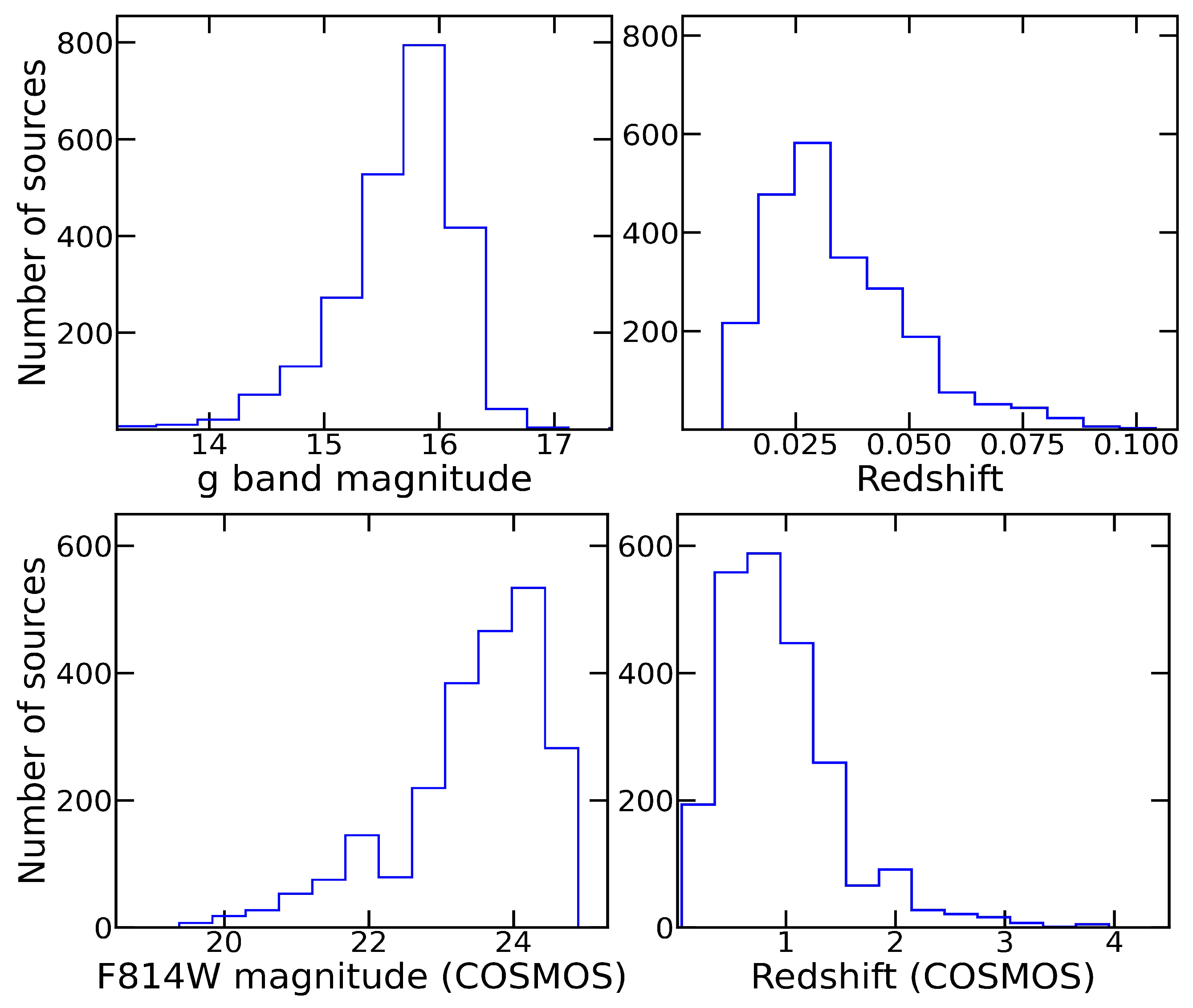
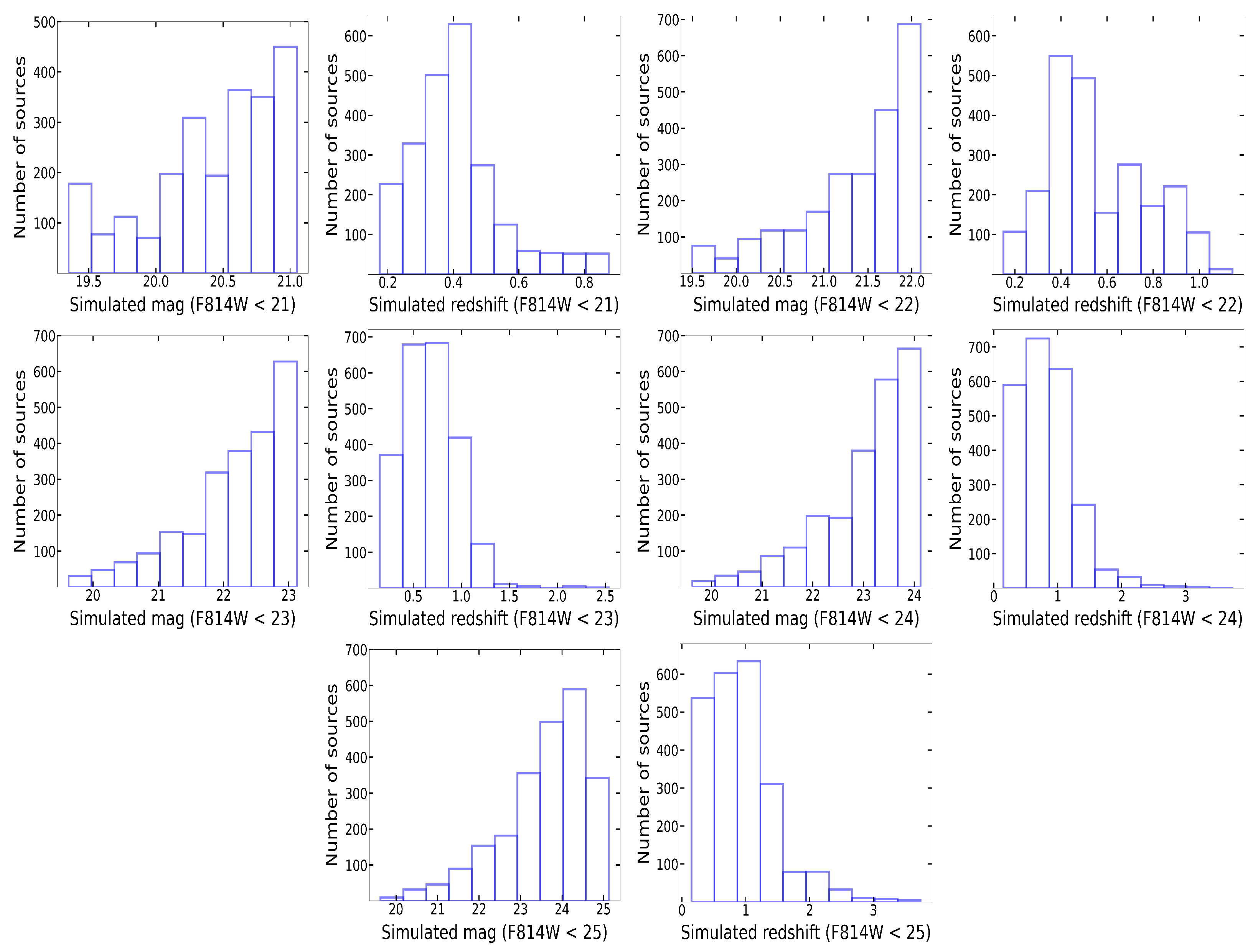

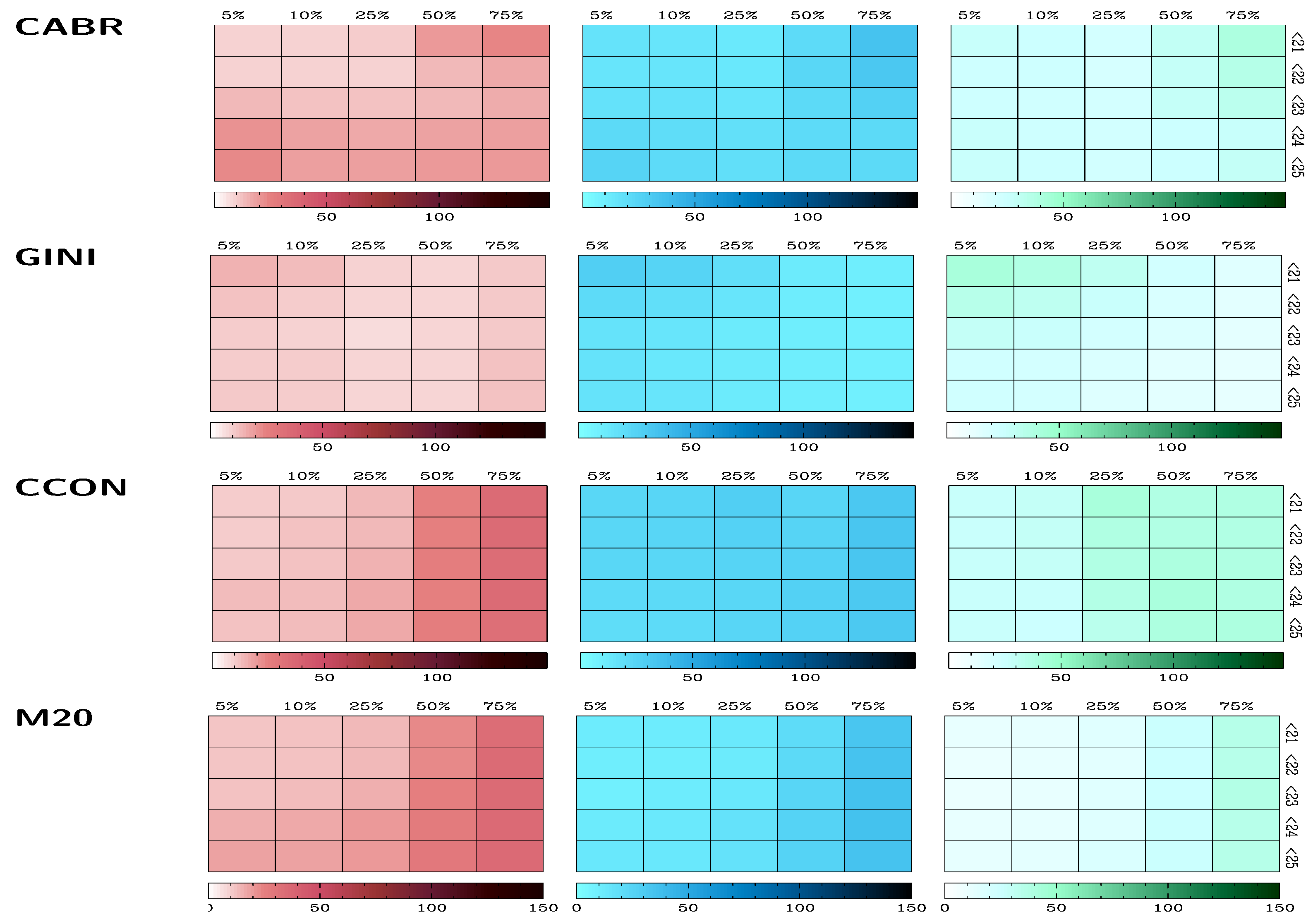
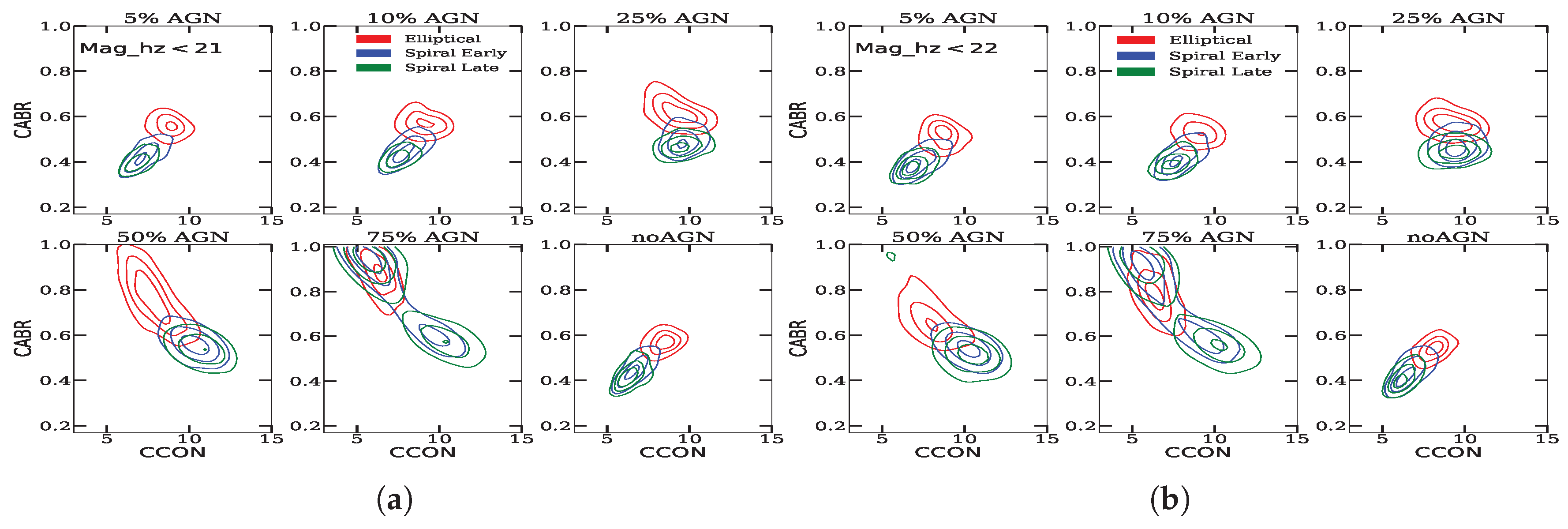


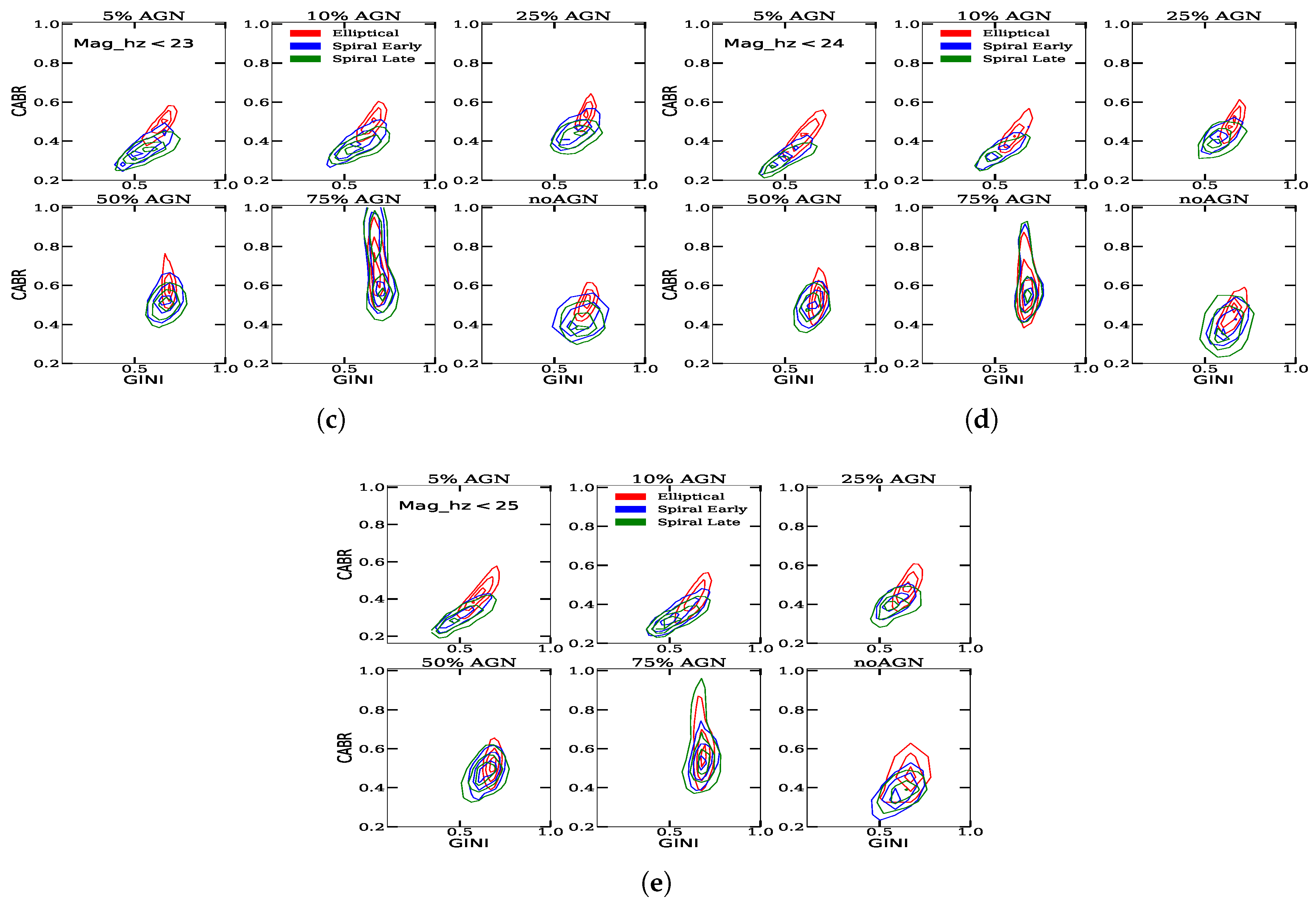
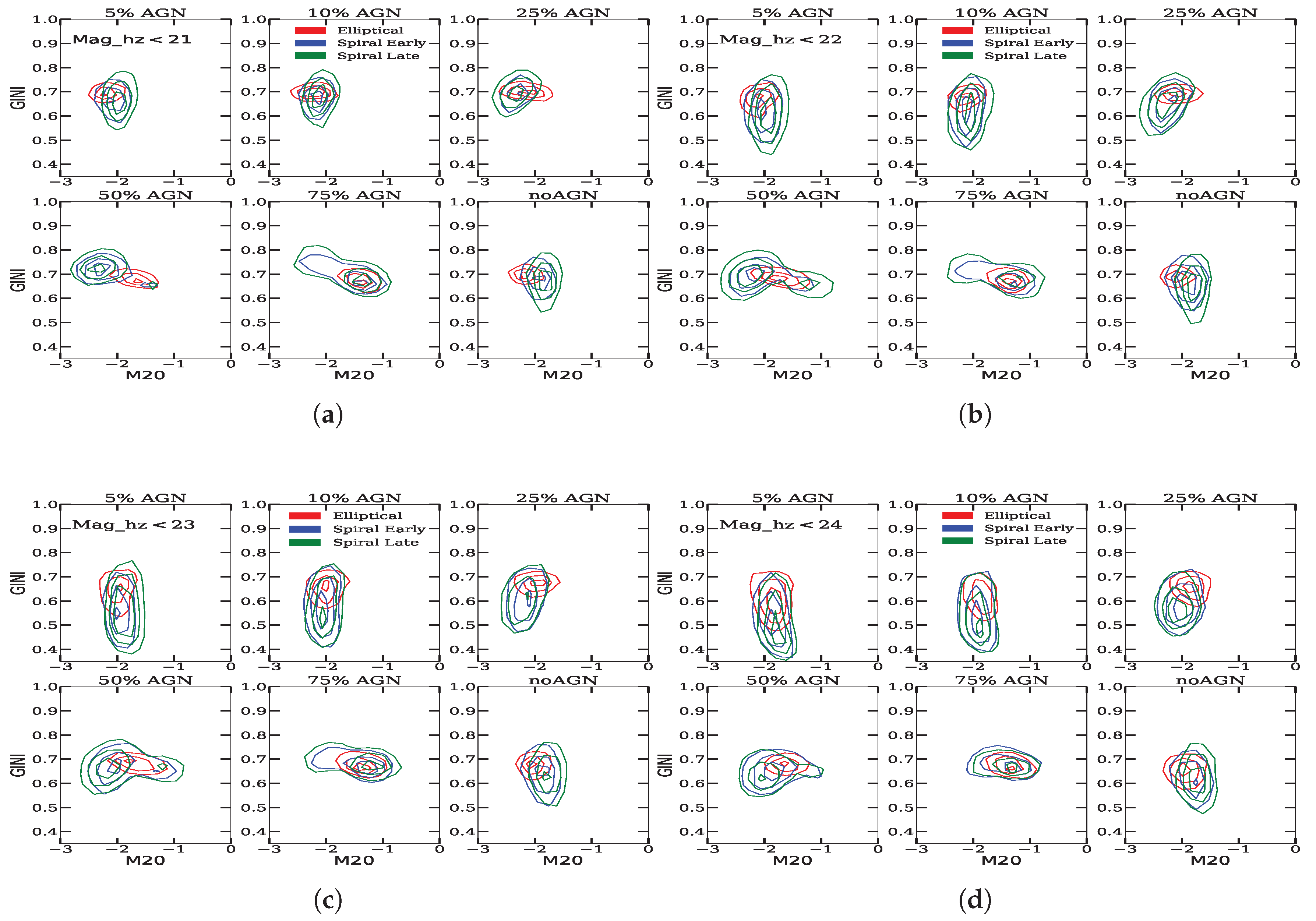
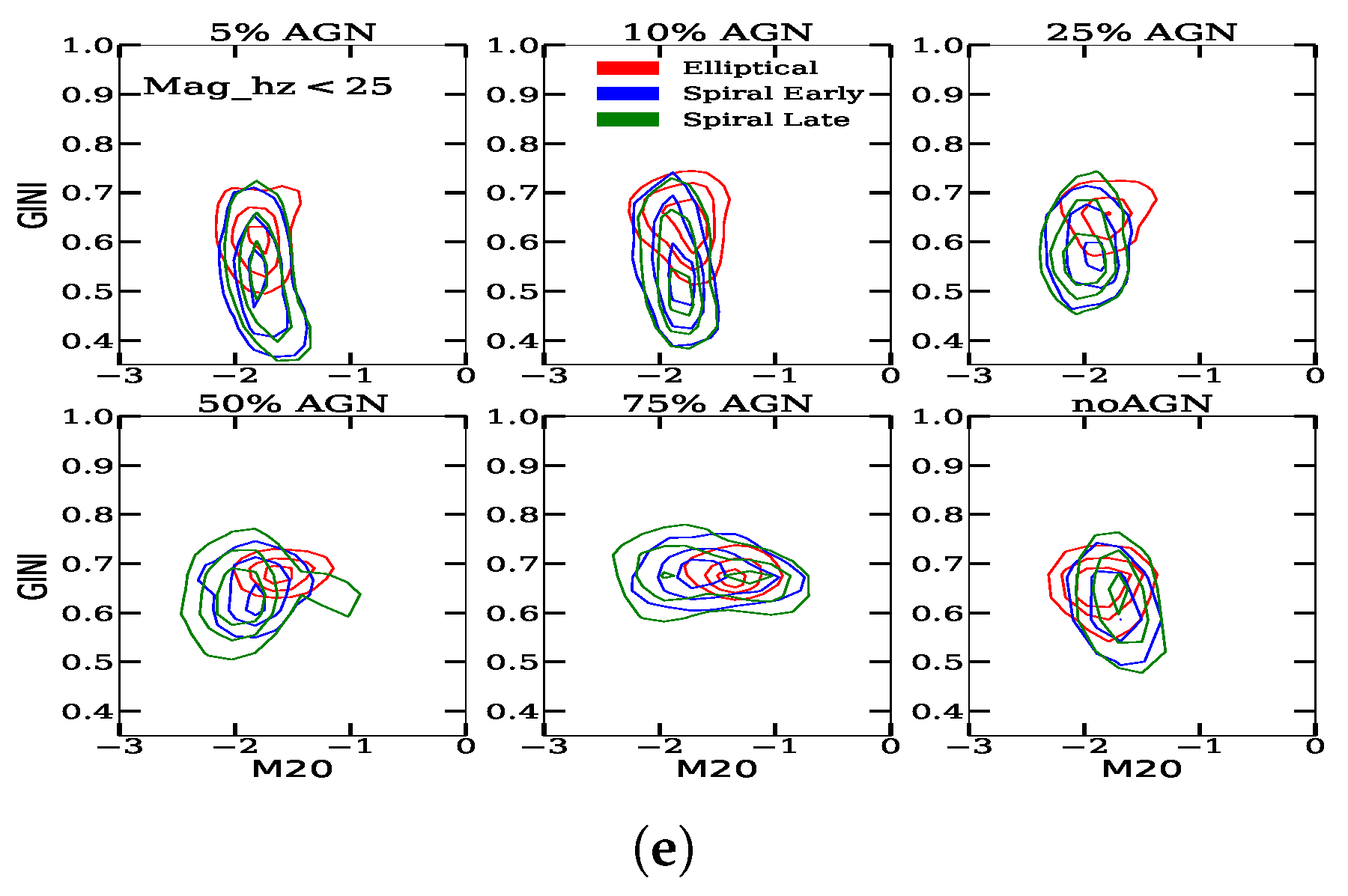
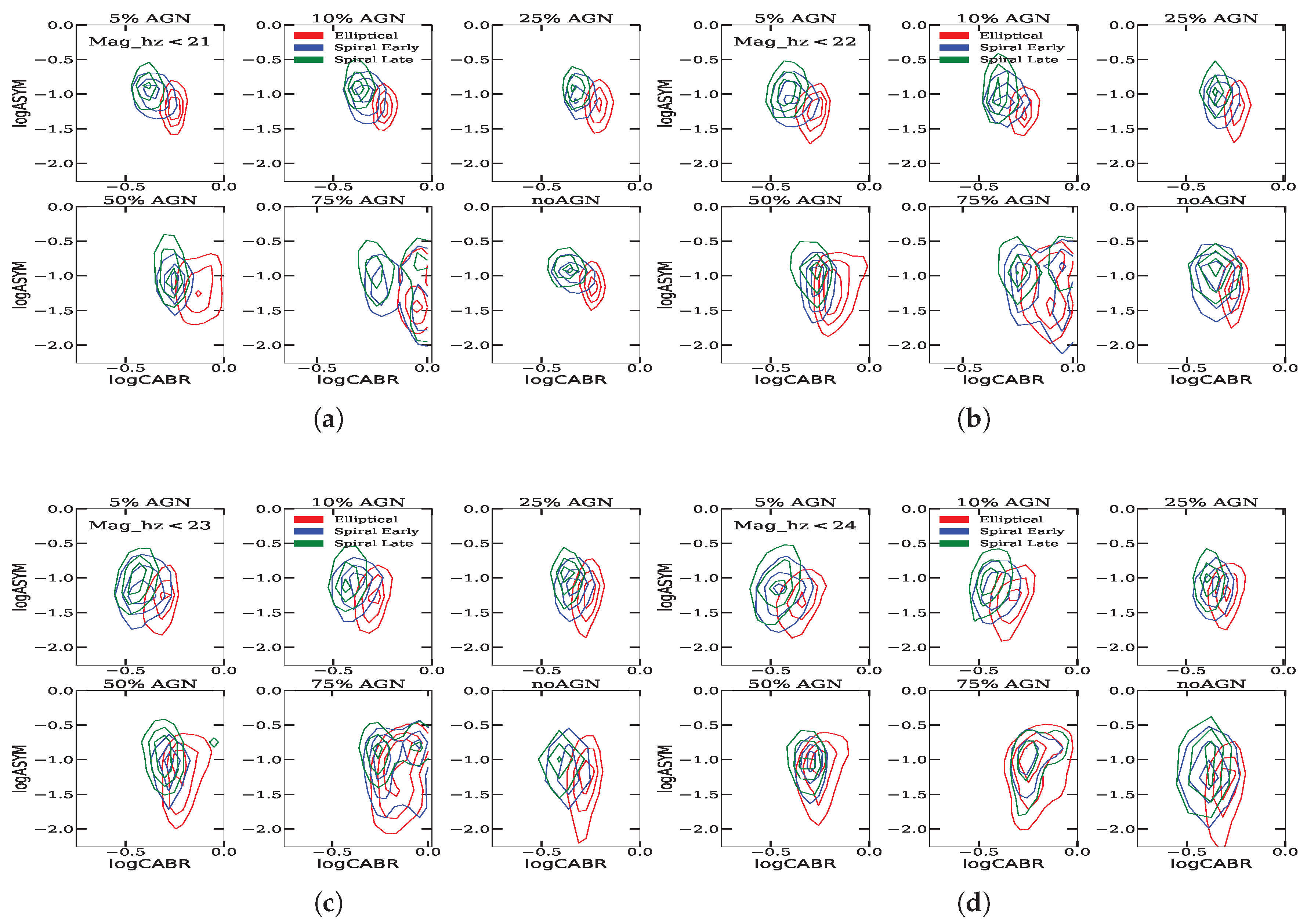

Disclaimer/Publisher’s Note: The statements, opinions and data contained in all publications are solely those of the individual author(s) and contributor(s) and not of MDPI and/or the editor(s). MDPI and/or the editor(s) disclaim responsibility for any injury to people or property resulting from any ideas, methods, instructions or products referred to in the content. |
© 2025 by the authors. Licensee MDPI, Basel, Switzerland. This article is an open access article distributed under the terms and conditions of the Creative Commons Attribution (CC BY) license (https://creativecommons.org/licenses/by/4.0/).
Share and Cite
Getachew-Woreta, T.; Pović, M.; Perea, J.; Marquez, I.; Masegosa, J.; Mahoro, A.; Mengistue, S.T. Contribution of AGN to the Morphological Parameters of Their Host Galaxies up to Intermediate Redshifts of z ∼ 2. Galaxies 2025, 13, 84. https://doi.org/10.3390/galaxies13040084
Getachew-Woreta T, Pović M, Perea J, Marquez I, Masegosa J, Mahoro A, Mengistue ST. Contribution of AGN to the Morphological Parameters of Their Host Galaxies up to Intermediate Redshifts of z ∼ 2. Galaxies. 2025; 13(4):84. https://doi.org/10.3390/galaxies13040084
Chicago/Turabian StyleGetachew-Woreta, Tilahun, Mirjana Pović, Jaime Perea, Isabel Marquez, Josefa Masegosa, Antoine Mahoro, and Shimeles Terefe Mengistue. 2025. "Contribution of AGN to the Morphological Parameters of Their Host Galaxies up to Intermediate Redshifts of z ∼ 2" Galaxies 13, no. 4: 84. https://doi.org/10.3390/galaxies13040084
APA StyleGetachew-Woreta, T., Pović, M., Perea, J., Marquez, I., Masegosa, J., Mahoro, A., & Mengistue, S. T. (2025). Contribution of AGN to the Morphological Parameters of Their Host Galaxies up to Intermediate Redshifts of z ∼ 2. Galaxies, 13(4), 84. https://doi.org/10.3390/galaxies13040084






